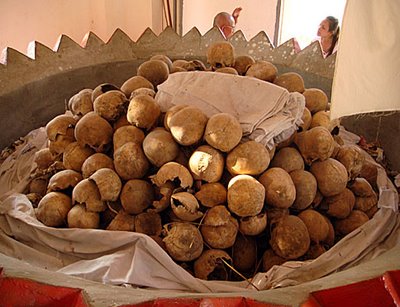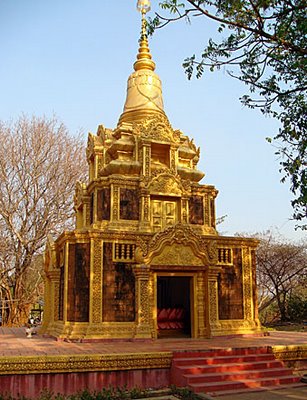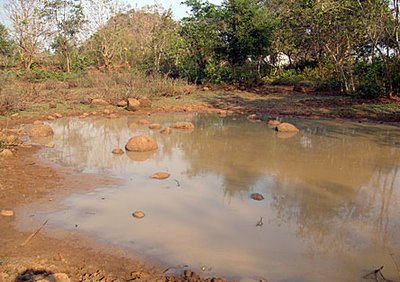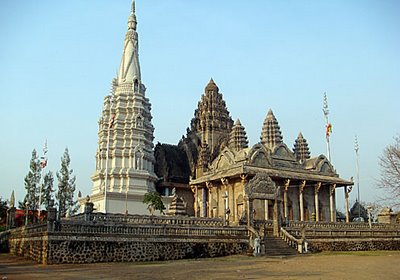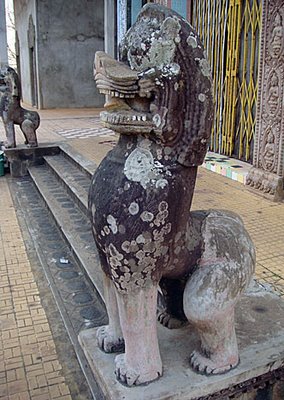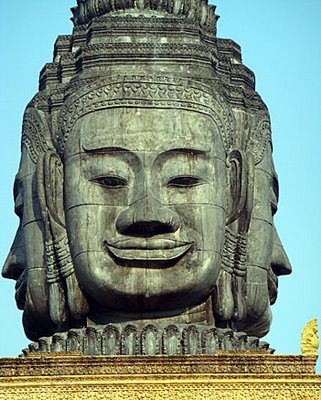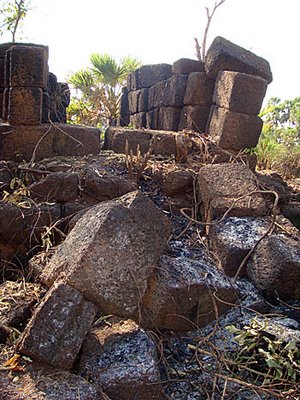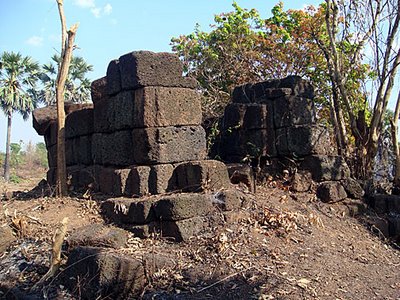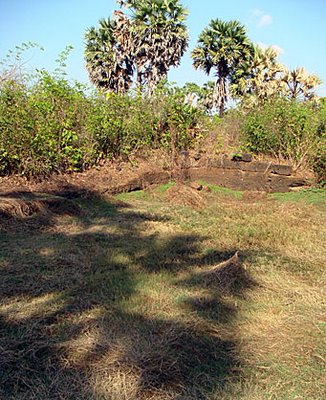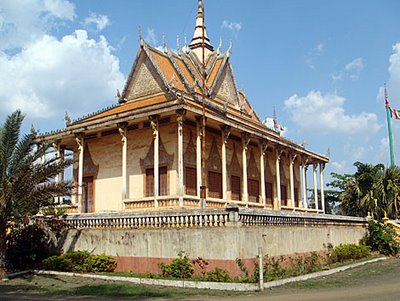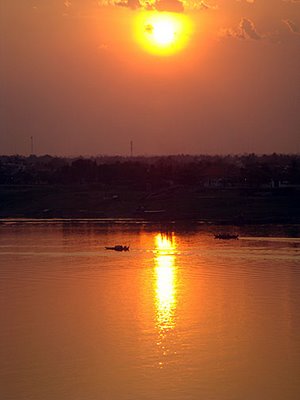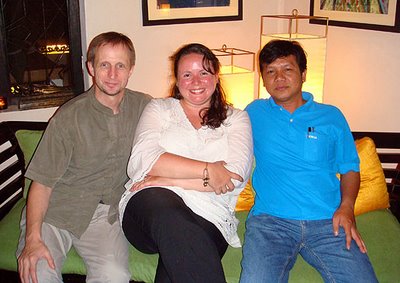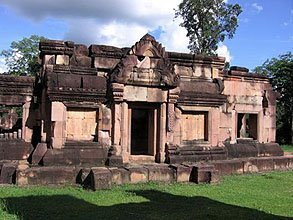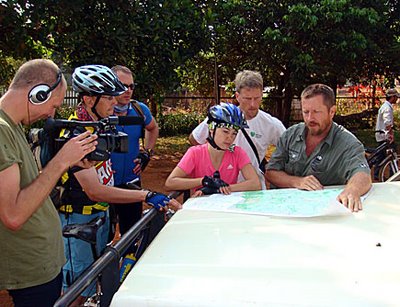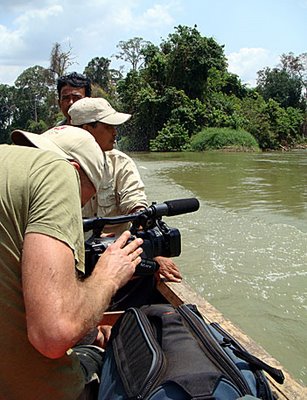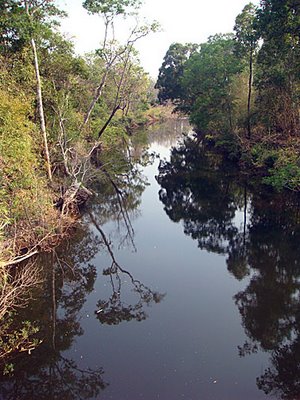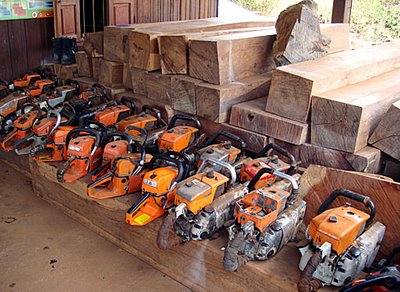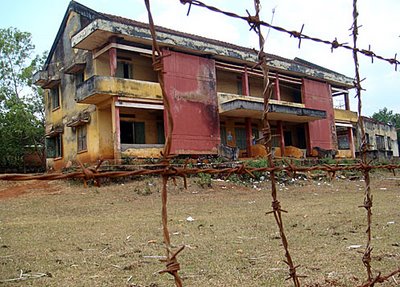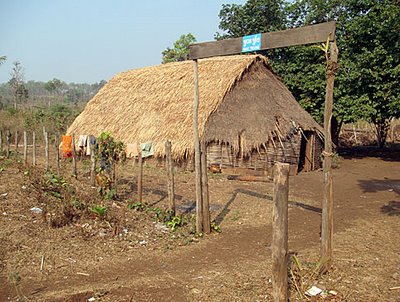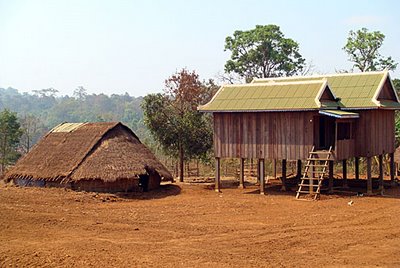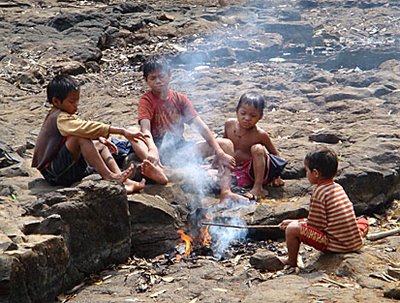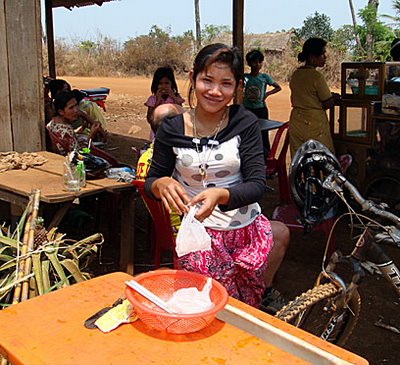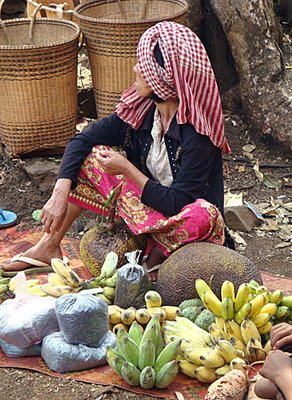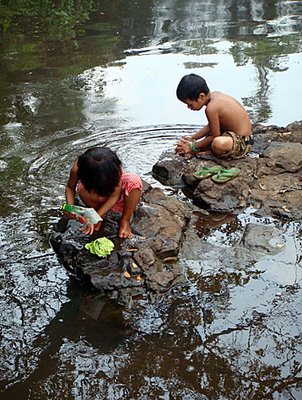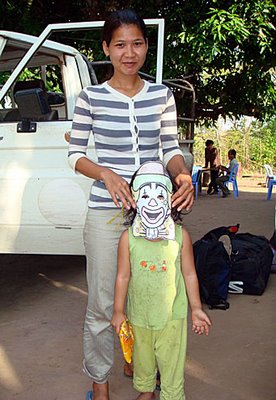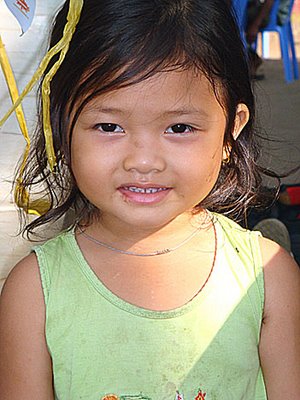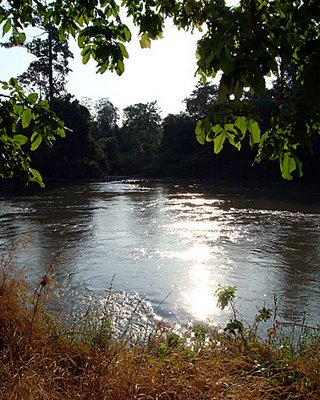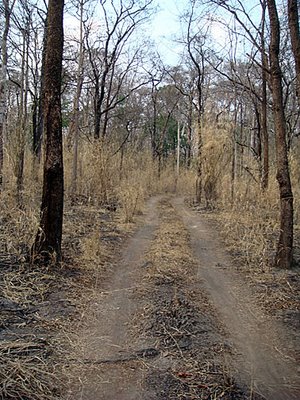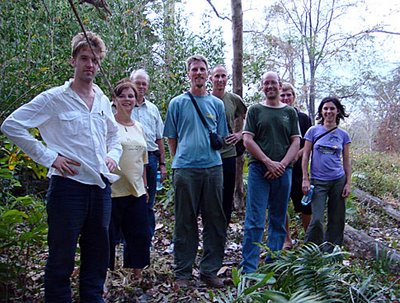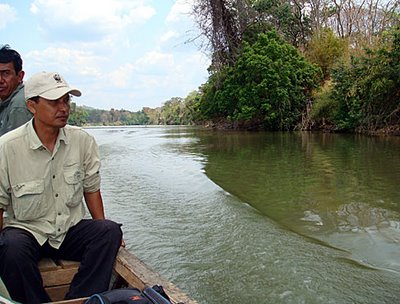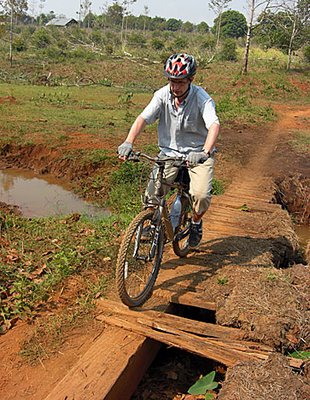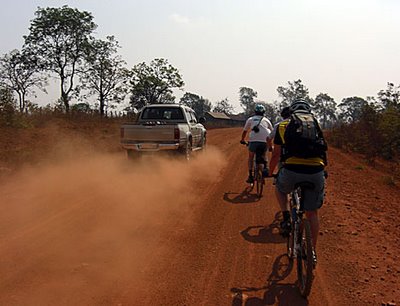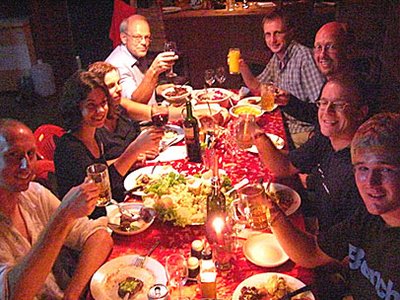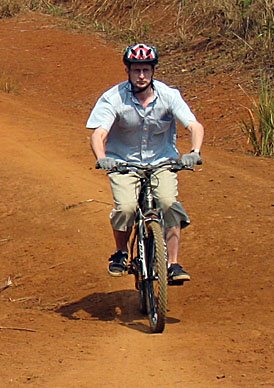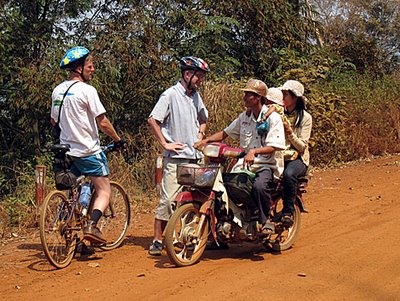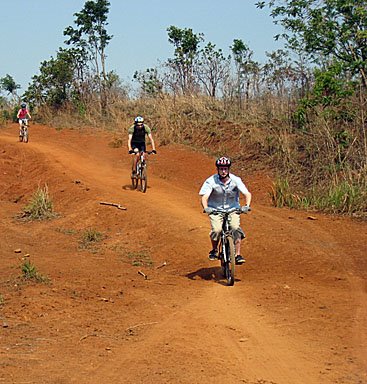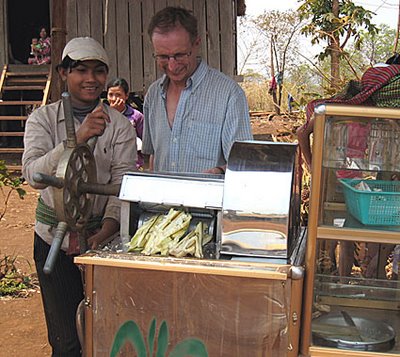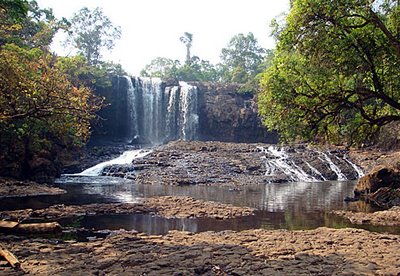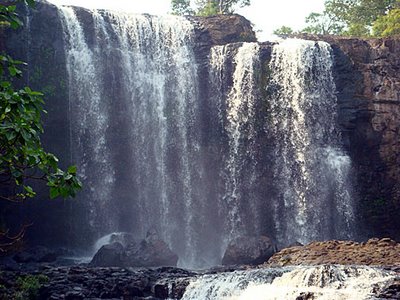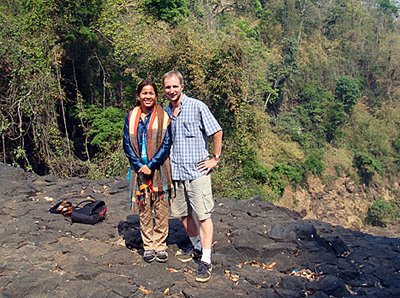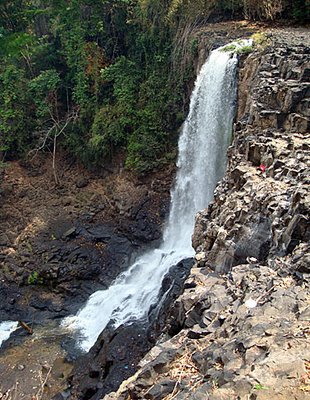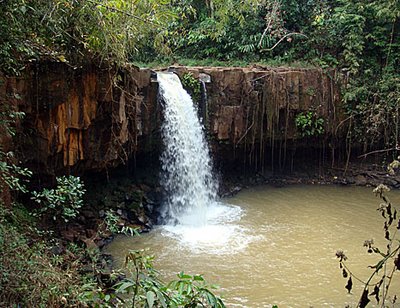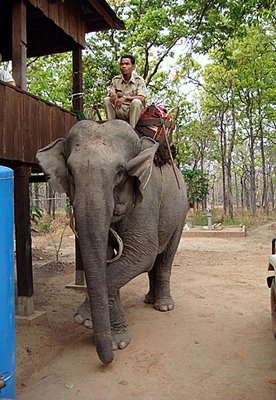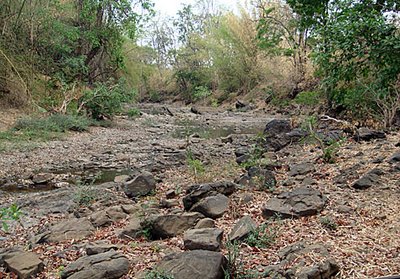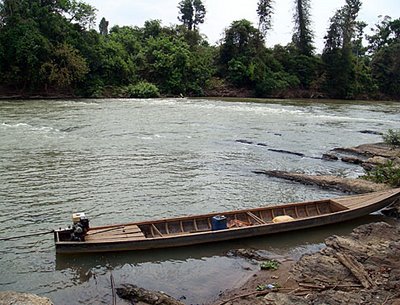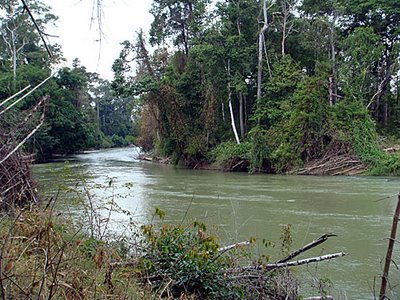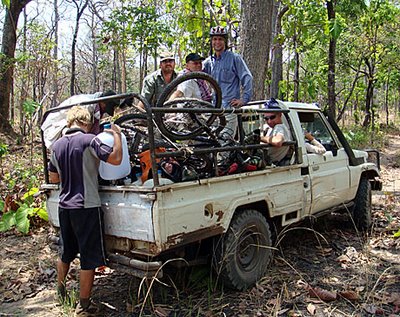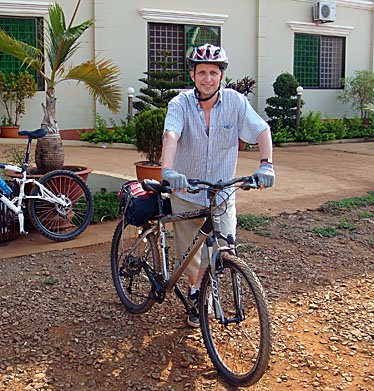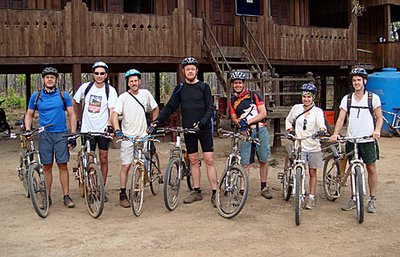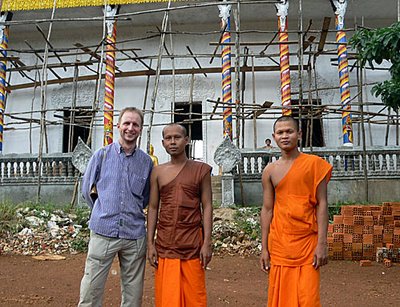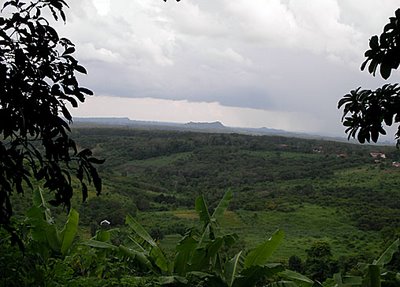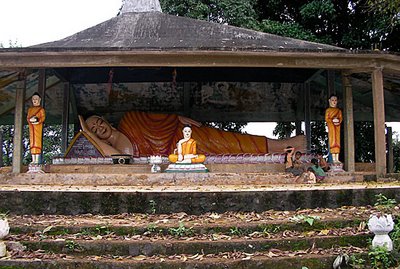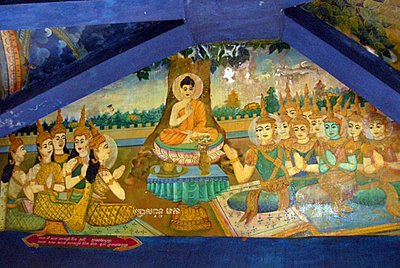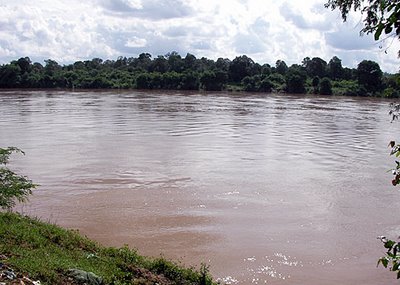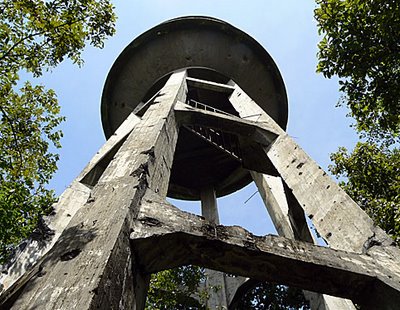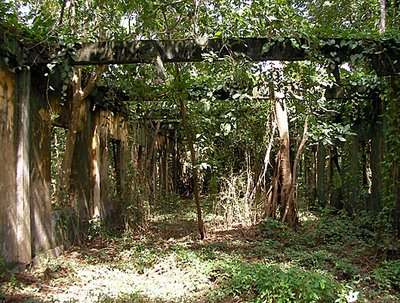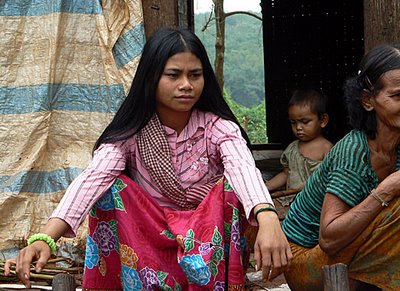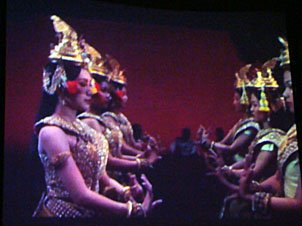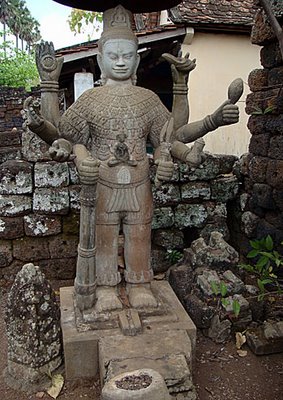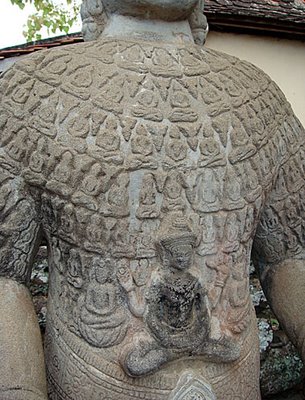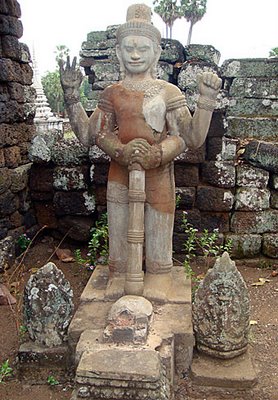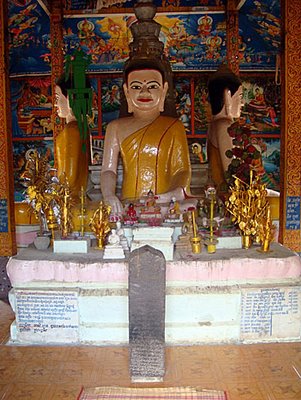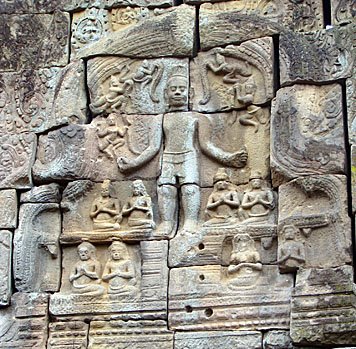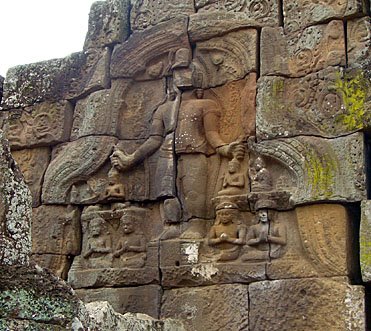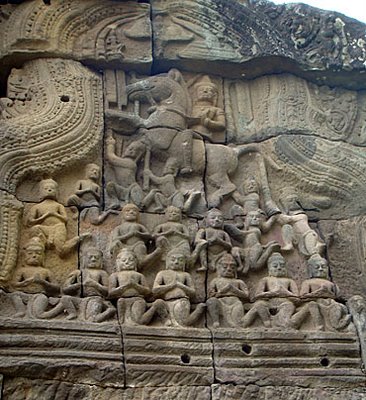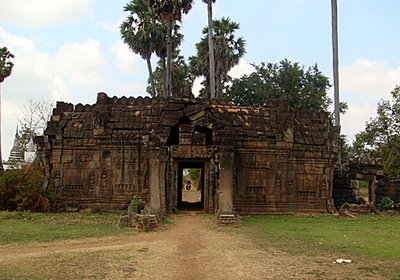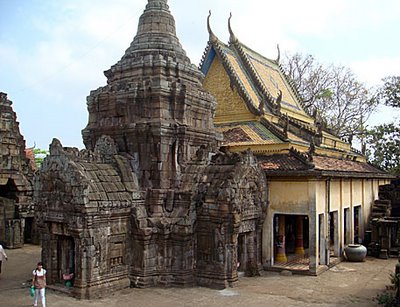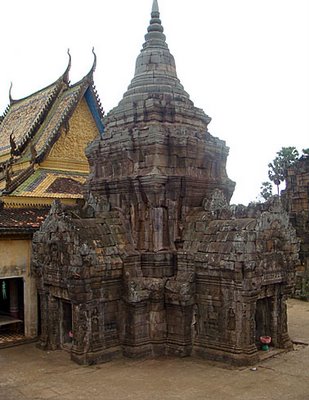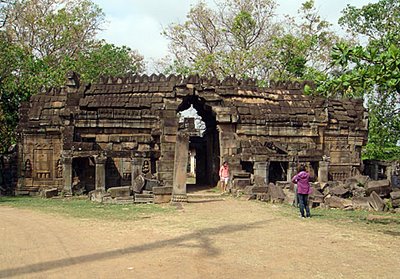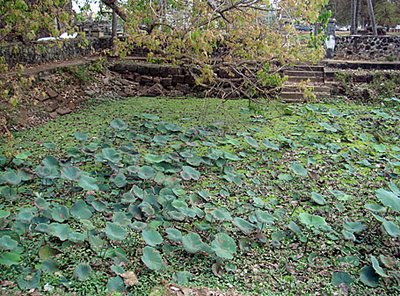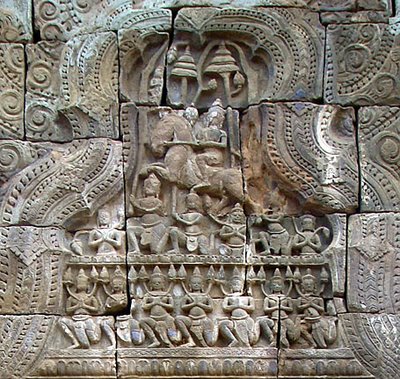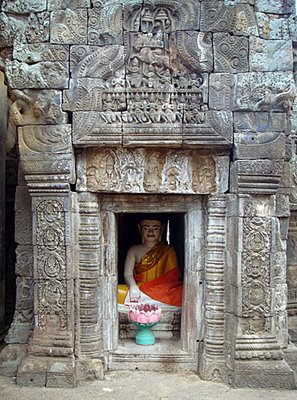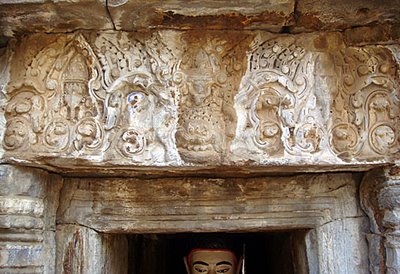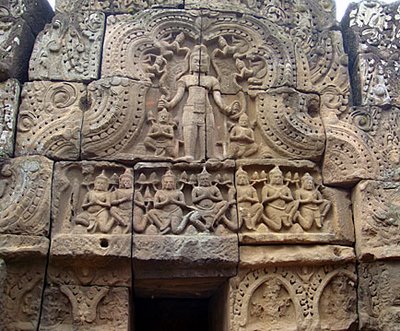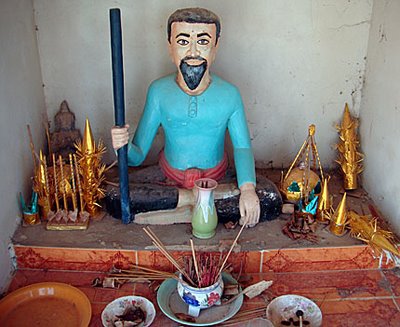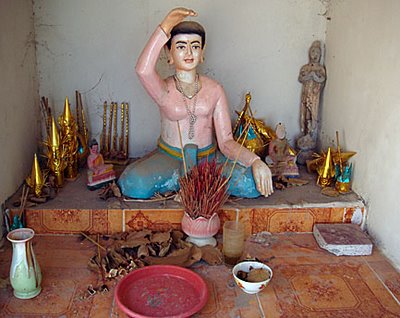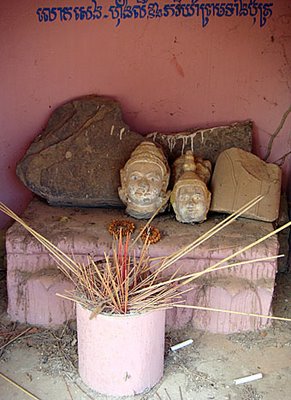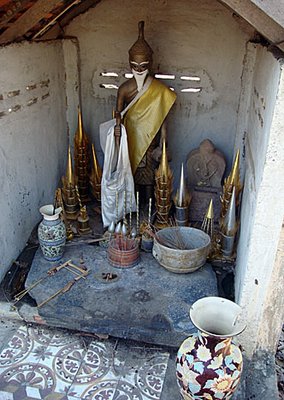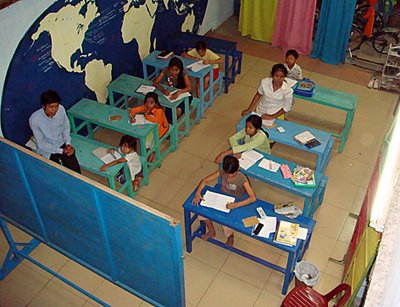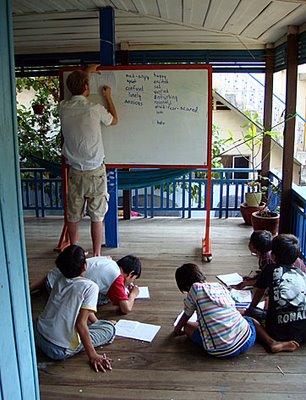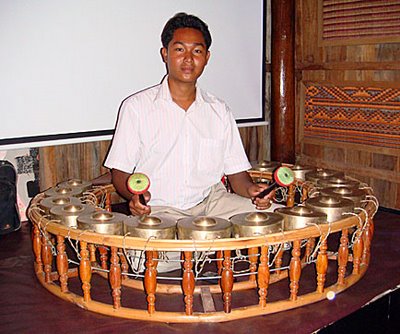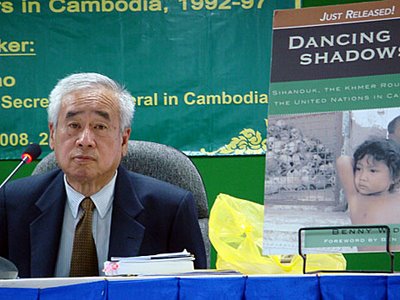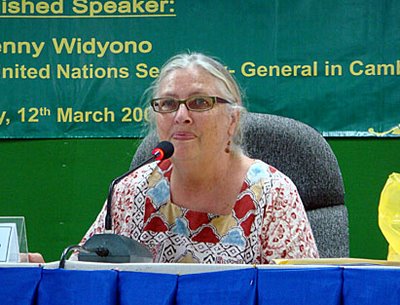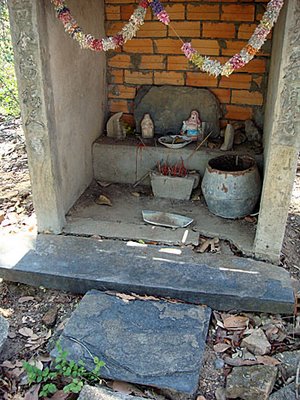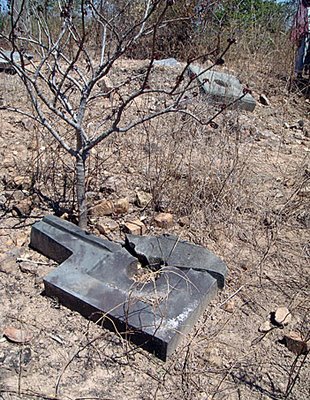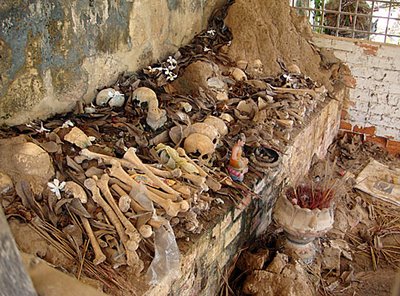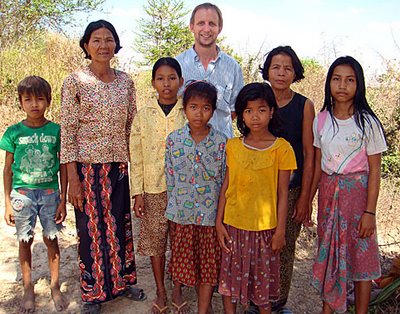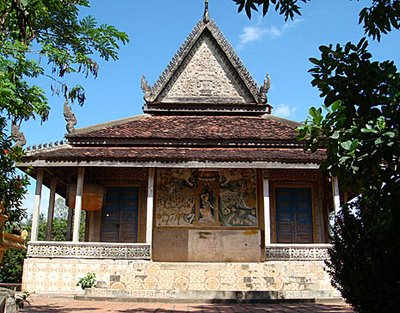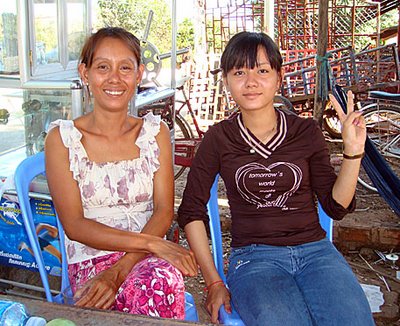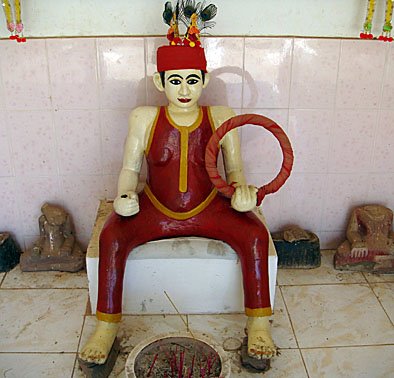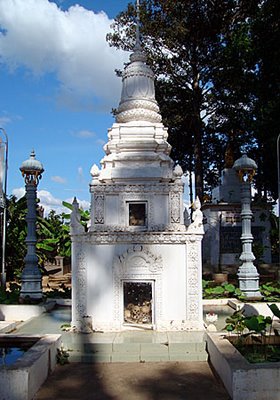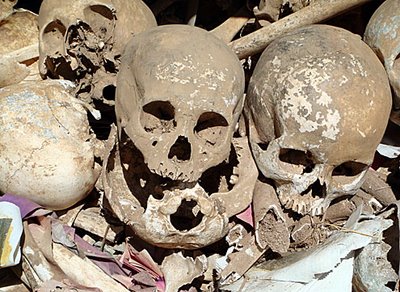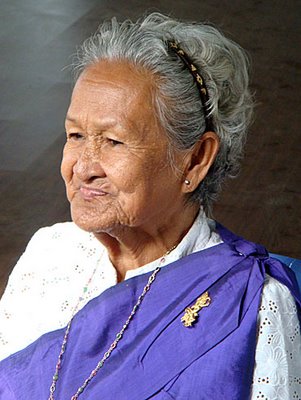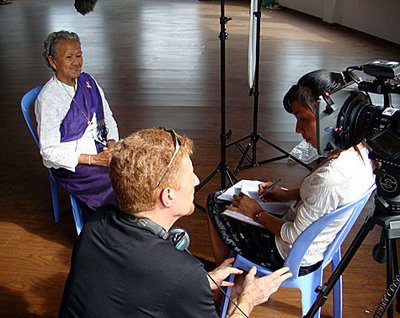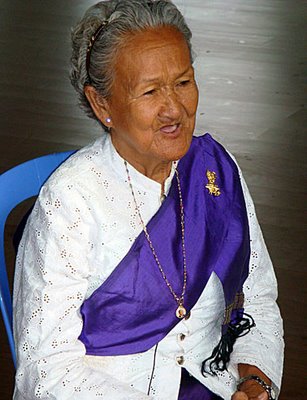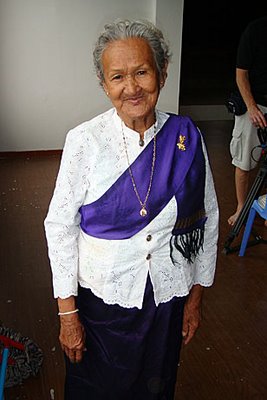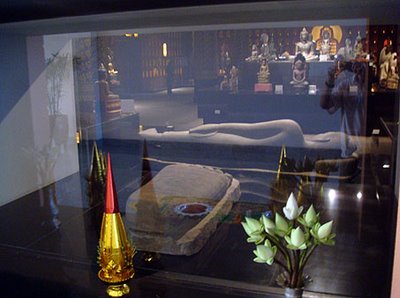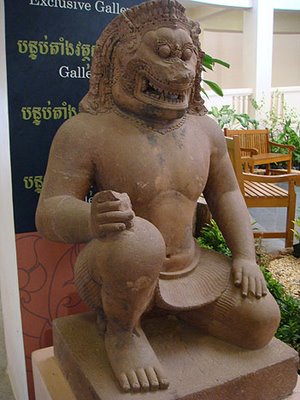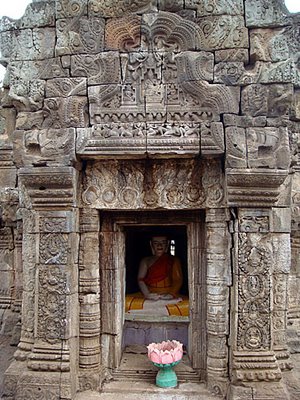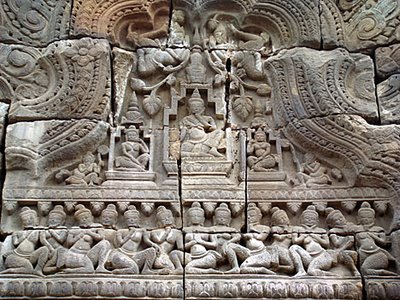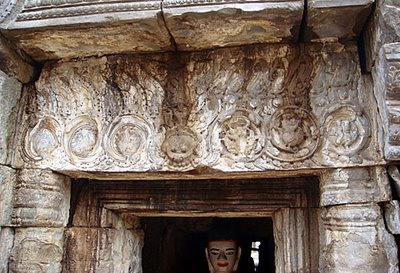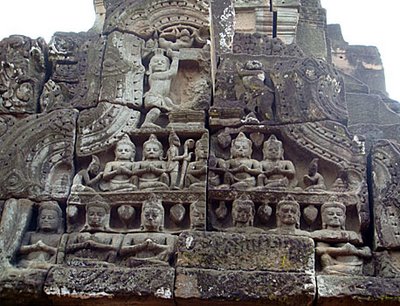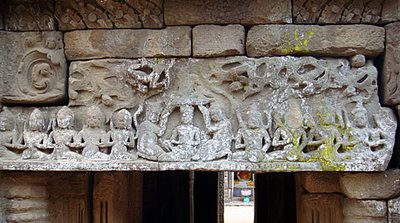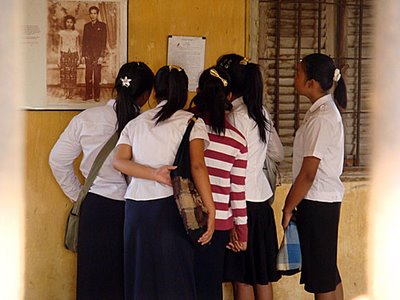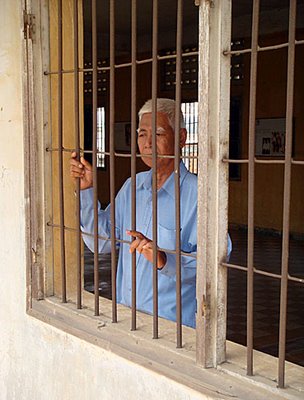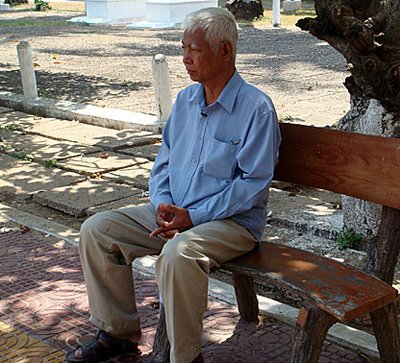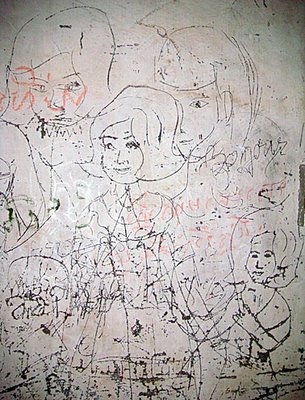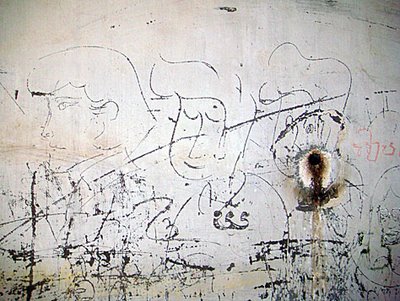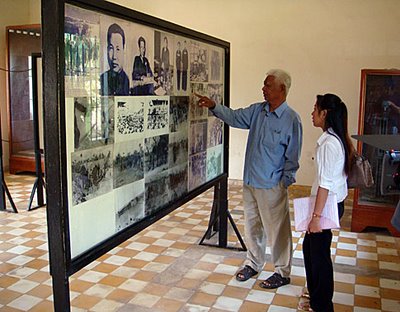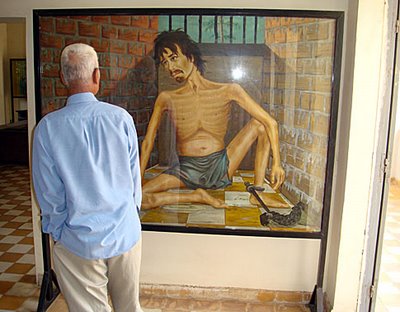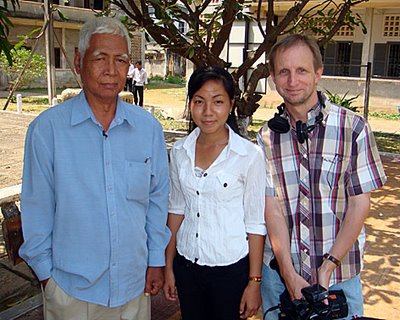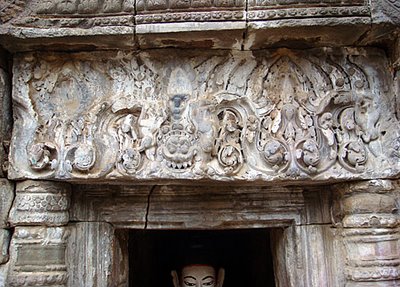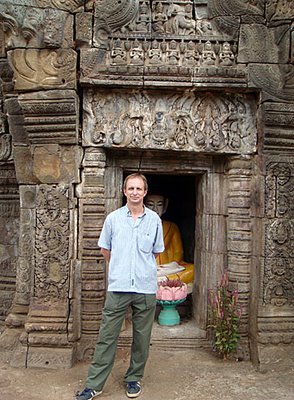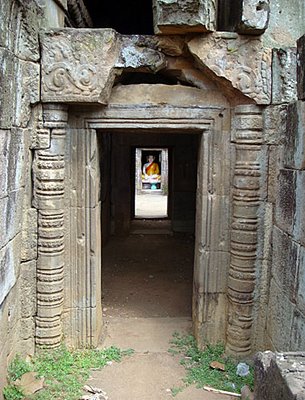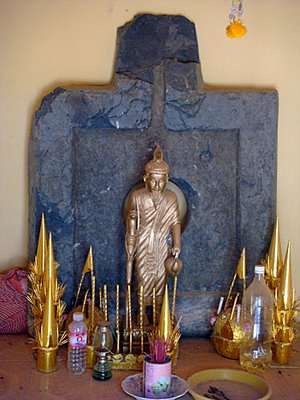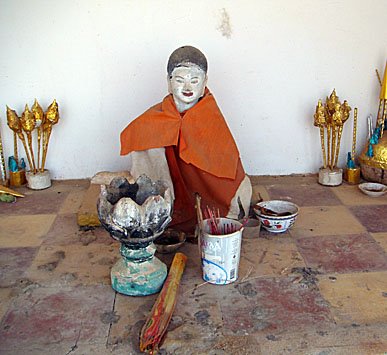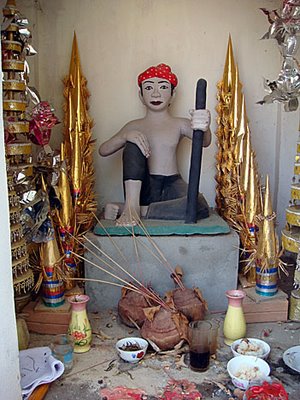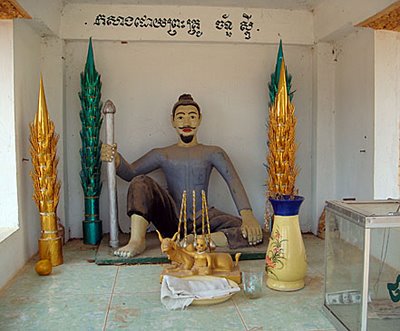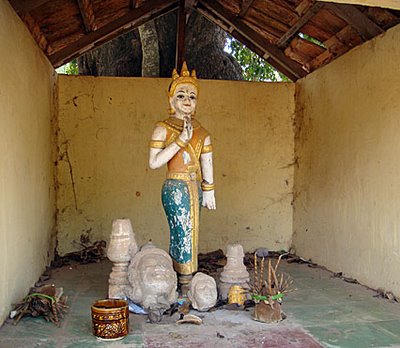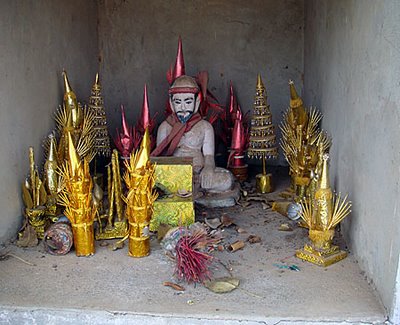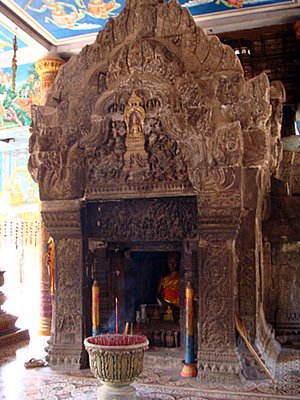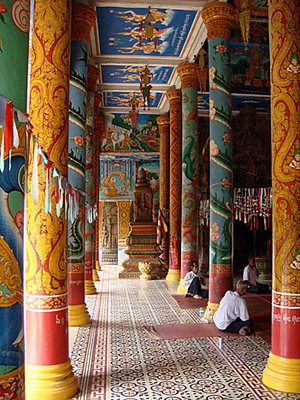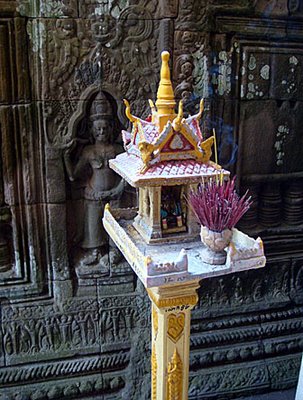Sunday, March 30, 2008
One of the Preah Theat's
On the way to Suong, I called into the massive Chup rubber plantation compound for a look around as I headed for what I thought was a genocide memorial at Wat Preah Vihear Tontim. Unfortunately, I was thwarted as the laymen at the temple told me that the memorial and the victims remains were removed in the late '80s, whilst the laterite prasat that was formerly located next to the pagoda's vihara was completely destroyed decades ago. Just a few laterite blocks remained in the undergrowth. More disappointment followed when they told me that another genocide memorial at Chamkar Svay, the site of a Khmer Rouge prison and burial ground a few kilometres away, had also been destroyed. In addition, the area was known for a spate of moto robberies in recent months so I decided to skip it and carry onto visit Kok Preah Theat Ponnareay. You have to be prepared for some disappointments along the way in Cambodia and this day was certainly not one of my most successful.
Into the unknown
Phnom Chi is better known for its gold deposits and the active goldmining concessions on Phnom Chi mountain itself and in Snang An a few kilometres away. Phnom Chi lies approximately 100 kms east-northeast of Kompong Thom city but we're expecting the road to the area to be no more than a track. We will be going on motos and camping overnight for a few nights, wherever we can find a suitable location. This is temple-hunting at its most basic. Phnom Chi gold has been known about for a long time though all mining activity - effectively it was done by local farmers using a straightforward panning technique - was stopped during the civil war of the '70s and resumed in the '80s despite the area being under Khmer Rouge control. Locals paid taxes to the KR to mine the deposits. After the government sent the army into supervise the area, the miners merely switched the payment of taxes to the military and mining activity has boomed ever since. Independent mining is now banned in the area, the concession has been granted to a locally-owned company, who in turn provide a basic wage of around $2 per day with three meals to the workers who mine the ore in shaft-mining to a depth of fifteen metres. Acid and cyanide is used to extract the gold from the mineral ore though this led to large-scale cyanide poisoning in the area and in nearby Stung Chinit River a few years ago. Malaria is also prevalent in the heavily-forested area, so I'm already asking myself, "why am I going?" The thrill of discovery and to see another remote part of the country are the main attractions, though nothing is guaranteed. My fingers are crossed. If I find a lost city in the jungle, I'll let you know.
Aw shucks....!
I was disappointed to see a news report that the Latin pop singer Ricky Martin is in Cambodia, as I was hoping to break that story. I was asked to keep mum for a few days after Ricky arrived in the country a couple of days ago but it seems someone else couldn't wait to spill the beans. Oh well, no big deal, I'll get over it. Ricky, known for his Living La Vida Loca song, is in town to visit projects fighting child trafficking and sexual exploitation.
Nice to see some complimentary remarks by a few bloggers when I did a blog search on my own blog tonight. My thanks to them. Here's what they had to say:
Carl Parkes posted on 15 March, 2008: While this blog may seem obsessed with Thailand, it's only because Thailand seems to consistently produce the most interesting and varied stories within Southeast Asia. Surprisingly, Cambodia is now in the second place, the country that inspires the most offbeat, culturally attractive, and socially challenging stories I find on the net. Indonesia should be second on this list, but it's not really generating stories I feel would be of great interest to the readers of the blog, and that's a pity. Check the blogrolls on the right and you'll see that Thailand has an overwhelming number of blogs or websites that I think are worth visiting or putting in your RSS reader. Not much for Cambodia, but that deficit is made up for by the excellent and consistent posts from Andy Brouwer, who works in the travel industry in Phnom Penh, and so has good reason to wander around the country visiting the more remote locations. He's interested in architecture and old temples (same as me) and speaks enough Khmer to ask the old monks to unlock doors to photograph rarely seen interiors. And his photography is surprisingly good, especially with his flash shots that aren't terribly washed out...something that has always been a problem with my photography. And so, today, I salute Andy Brouwer and his great site about all things Cambodia.
Erik posted the following on 10 December 2007 at Buddhismadjunkt. Andy Brouwer Starts Roaming: It’s always been fun to read Andy's blog - for one thing, he seems incapable of having negative opinions or thoughts. Let me say first off that I don’t always like this: too often in my experience, people with nothing ‘negative’ to say are just in the business of getting along and trying to be liked. But that is clearly (to me, anyway) not the whole of the story with Andy, whose genuine-ness and overwhelmingly obvious love of Cambodia overcomes my suspicious nature. Or maybe it’s just the fact that he shares my love of conscious reggae greats, Steel Pulse, whose Earth Crisis album I found in a public library in Topeka, Kansas, and which changed my life. Since moving to Cambodia (lucky sunavagun), Andy’s been prowling around like only a single man on a mission can do. I’ll readily admit that I’m horribly jealous; and also that I’m enormously grateful for the commentary, the photos, and as always, Andy’s good nature. Not only has he been prowling, but he’s been spending an awful lot of time dealing with my specialty - Cambodian thoughts, ideas, and especially rituals, that might be classified as ‘religious.’ Here he is at the Famed Phnom Baset temple, with the magic monk himself, getting his cell phone blessed, and watching others get splashed with water (a common ceremony called srauch teuk), traipsing around an apparently completed Wat Trai Leak (on the Chruoy Changvar peninsula, I’ve visited many times, but it’s quite a lot further along than I’d imagined possible), adding new genocide memorials to his list of ones visited, and visiting the famed Tampuon cemeteries in Ratanakiri.
Bob Uva wrote on 26 January 2008: The other voice, written not spoken in this case, is that of Andy Brouwer, an expat Brit living in Phnom Penh, the capital of Cambodia. I was unable to keep up my reading pace through the past week due to this cold, and Andy has a tendency to become extremely prolific in his blog postings over a short period of time. Fortunately, today I have felt well enough to flee the home for a coffee shop and get some uninterrupted reading in. I had over twenty unread entries in Andy's blog going back to December 30th, so I decided to start there. And am I happy I did. The mix of travelogue, history, humor and humanity that Andy weaves in his writings is truly remarkable. My heart was warmed by the pictures of Khmer children he met at temple visits or along the road, then it is wrenched from my chest as I observed the piles of skulls at the genocide memorial at Sala Trapeang Sva. Then the "three sreys" restored my hope and the painted pagoda at Wat Kork Ksang made me yearn to visit. I felt myself being very thankful that I had been introduced to Andy's blog (thanks Kilong) for his light-hearted as well as his serious jaunts around that beautiful country have been a joy to follow. And finally, he has recommended a book that I am looking forward to reading: The Judas Strain by James Rollins. Andy's recommendation mentions that he's a Robert Ludlum fan. I devoured the Bourne series and am looking forward to reading another author of a similar vein.
Saturday, March 29, 2008
How can this happen?
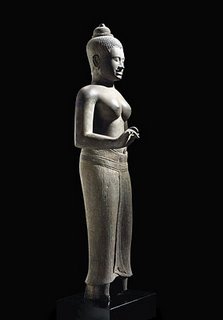 This 11th-century statue in the Baphuon style fetched $2.11 million at Christie's (Photo: Sotheby's)
This 11th-century statue in the Baphuon style fetched $2.11 million at Christie's (Photo: Sotheby's)Some of the sales included the following:
A sandstone figure of a woman carved in the 11th century in the style known as Banteay Srei and described as having been acquired in 1986 was missing its head, very neatly chopped off, and both feet. It's commercial performance was not affected and it raised $361,000, nearly six times the estimate. Next, a 12th-century bronze bodhisattva from the Angkor period. No provenance at all here, no date of acquisition. The 34 centimeter four-armed statue did not sell so well, and only went under the hammer for $73,000. It was followed by a 13th-century bronze figure of Ganesha seated on a pedestal cast in the Bayon style, which exceeded its high estimate by half, climbing to $52,000. For this item the catalogue noted "Provenance. Hong Kong Collection, 1980s," implying little more than it had been in Hong Kong at some stage. This complete disregard for its Cambodian origin is blatant and grossly shameful. Two days later, at Christie's, things got a lot hotter. A Khmer statue of the 11th century in the Baphuon style had surfaced in the market in 1968, two years before the UNESCO cut-off line of 1970, after which goods of uncertain provenance are deemed less legitimate. At $2.11 million, it now holds the world record for Khmer sculpture.
Water everywhere
To keep you in the picture regarding recent press reports, here's a few links that will highlight the current concerns:
Eric Coull in the Bangkok Post with his article, The Mekong: Charting a sustainable future here.
Rob Sharp's A Poisoned Paradise: Cambodia's Water Crisis, for the Independent in the UK here.
Asia Times' Andrew Nette's article called Cambodian dam plans suffer information drought here.
and finally Ek Madra's article Chinese dams threaten Cambodia's forests, farmers here.
Rachel in the news
Woman fights against discrimination in Cambodia by Anna Dowdeswell The Bucks Herald, UK
She said: "I spent my time teaching basic English, crafts, sports, music and was able to support the orphanage by providing bicycles, rice and school uniforms." She also worked in two schools, one in Battambang district in the west and Prey Chrouk in the south. She taught English, painted classrooms and with the help of the IAM Foundation installed two water pumps. "My time working with these NGO's has changed my life and settling back into corporate life in the UK has been difficult. I have made some wonderful, long-lasting friendships, with both Khmers, particularly my 'family' in Battambang, and many ex-pats working in Cambodia. Cambodia is no longer just a holiday destination for me. I would love to have the opportunity to work out there for longer. Cambodia is quite simply my second home."
Friday, March 28, 2008
Cambodia Dreams
Changing themes, there's an Apsara classical dance show by students of the Royal University of Fine Arts at the Art Cafe this evening. It kicks off at 7pm, so count me in. The Art Cafe is on Street 108, not too far from Phsa Chas.
Tomorrow evening (Saturday), Meta House will screen a couple of films by Director Peter Degen focusing on Cambodia and its life-sources, the Mekong and Tonle Sap. Mekong - The Mother is a 45-minute feature looking at the Mekong River through its people, whilst the 52-minute docu When The Floods Recede, focuses on the fishermen and women who depend on the abundant supply of fish in the Tonle Sap.
Thursday, March 27, 2008
The Khmers
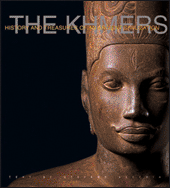 This large and imposing book arrived in the post today all the way from England and will keep me busy for a few days whilst I devour the text and beautiful photographs contained within. I'm already in the middle of about five different books, so one more won't make much difference! I never seem to get the chance to sit down and finish one of the books I'm reading in recent weeks. Very frustrating. This new glossy coffee-table sized edition is The Khmers (History and Treasures of An Ancient Civilization) by Stefano Vecchia and published by White Star in Italy and the UK a couple of months ago. In taking a peek its 200+ pages are full of colour photos from the temples themselves as well as a lot of the statuary to be found in museums like the National Museum in Phnom Penh and the Guimet Museum in Paris. I'll take a closer look and give you my opinion in due course.
This large and imposing book arrived in the post today all the way from England and will keep me busy for a few days whilst I devour the text and beautiful photographs contained within. I'm already in the middle of about five different books, so one more won't make much difference! I never seem to get the chance to sit down and finish one of the books I'm reading in recent weeks. Very frustrating. This new glossy coffee-table sized edition is The Khmers (History and Treasures of An Ancient Civilization) by Stefano Vecchia and published by White Star in Italy and the UK a couple of months ago. In taking a peek its 200+ pages are full of colour photos from the temples themselves as well as a lot of the statuary to be found in museums like the National Museum in Phnom Penh and the Guimet Museum in Paris. I'll take a closer look and give you my opinion in due course.
Prasat Ta Muen annual festival - in Thailand
I highlighted the difference of opinion between Cambodia and Thailand over this series of temples in my blog in December. To refresh memories, here's what I said at the time:
If you're not aware, one of my biggest passions is visiting ancient Khmer temples, dotted around the Cambodian countryside. However, there are a series of Khmer temples in northeast Thailand that I have yet to visit so I was particularly interested in a report from Radio Free Asia's correspondent Kim Pov Sottan yesterday which highlighted the issue surrounding the 12th century Angkorean temple of Prasat Ta Muen Thom - which is in fact three ruined structures all with the same generic name - in a location that seems to be on the very border between Cambodia and Thailand. If you speak to the Khmers in the locality, they'll tell you that the temple is Cambodian and that the Thai's have stolen it in the last few years, whilst the Thai's have assumed responsibility for the temple and built a paved road for easy access for visitors. The report from RFA suggested that even the Thai military commander for the area claims that the temple is in a 'white zone' which is technically a disputed, no-man's land.
Michael Freeman’s excellent Guide to Khmer Temples in
On the Tube
Besides the superhuman effort required for the cycling element of the tour, seeing wildlife was also high on the agenda as WWF and the Srepok Wilderness Project is busting its balls to establish an environment where the wildlife can recover and grow again after years of hunting, poaching and neglect in the region. Hunter turned gamekeeper, one of the top Park Rangers admitted to have killed no less than 10 tigers during his days as a poacher, but now its his job to protect the wildlife such as tigers, leopards, other cats, large cattle and rare birdlife. Early in the morning and around dusk are the best times to view the animals and birds and that's when I saw quite a few muntjac bounding across the forest floor, as well as Eld's deer, three different types of eagle, some squirrels and colourful parrots. Some of the group also saw gaur and banteng, two species of large wild cattle. No-one claimed to have seen any tigers, leopards, wild elephants or bears - we'll search for those on the next trip.
This was definitely an exploratory trip, and the area is some way off being ready to receive visitors. There is a clear opportunity for a range of tourism options in and around the Srepok River, from kayaking to cycling to bird-watching to safari tours to fishing, and so on, though WWF are not in the tourism business and will need a partner(s) to make it happen, successfully. Their plans for an upmarket ecolodge are still on the drawing board at the moment, and without the backing of other partners, that's where they will stay. However, they are optimistic and have an area to promote that is untouched and pristine enough to attract tourists looking for a different alternative to temples and beaches. The Srepok Wilderness area is definitely that. Incidentally, immediately following our trip, the American Ambassador to Cambodia was due to spend two nights in Mereuch to assess the progress being made by WWF. I hope he left his bike at home! Link: WWF
Wednesday, March 26, 2008
Final photos from Mondulkiri
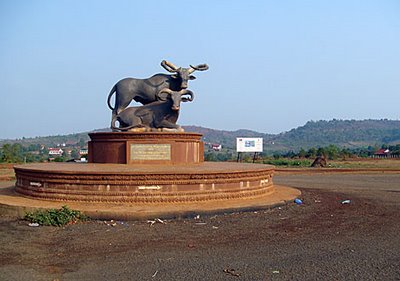 Seriously, I couldn't believe it. Two of the famously elusive Koupreys were just standing/sitting there are the top the main drag in Sen Monorom. What an exclusive! This picture will almost certainly be on the main newswires in the next few minutes.
Seriously, I couldn't believe it. Two of the famously elusive Koupreys were just standing/sitting there are the top the main drag in Sen Monorom. What an exclusive! This picture will almost certainly be on the main newswires in the next few minutes.The Pnong
The Phnong are the indigenous peoples of Mondulkiri, although considered a 'minority' they in fact make up the majority of the population of Mondulkiri Province. The Phnong are believed to have been living in the Mondulkiri area for around 2,000 years, they traditionally have a strong link with their natural environment, hunting in the woods around their villages as well as collecting foodstuffs and other non-food products (such as timber or tree-sap) from the woods. Traditionally the Phnong do not take products from the forests that they do not need themselves, and therefore have a minimal impact on their environment. The Phnong's religious/spiritual beliefs are animistic, this is to say that they believe all things have spirits - animals, plants, hills, stones, jars, buildings - everything. Their ancestors are also represented by spirits. If these spirits are unhappy because of some human action they can intervene in the life of the Phnong, to harm or protect them. Sometimes it is necessary to appease the spirits with ceremonies/rituals, including animal sacrifice.
The Phnong are a traditionally autonomous and self-governing society in which village elders are looked to to solve internal disputes. If it is decided that a 'law' has been broken then it may be that the guilty party would have to pay a fine to the village, and also need to carry out some ceremony as noted above. Crimes which are relatively common in the West and in much of 'developed society' as a whole - such as thefts, physical violence, rape, and murder - are practically unheard of in Phnong society. There is little documentation of the Phnong up until the French colonized Cambodia in 1864. A road was built linking Sen Monorom to Kompong Cham, though Mondulkiri remained sparsely populated (as it does today with only 2 people per square kilometer). In the 19th century the Phnong had a reputation for being particularly warrior-like in their resistance to the French army. In 1969-1970 Mondulkiri fell under Khmer Rouge control and as a consequence much of the population was displaced to Koh Nhek, where the people were forced to work in rice paddy fields. It was not until the 1980's that the Phnong were allowed to return to their villages and traditional homeland. Then they were provided with weapons to protect themselves from possible Khmer Rouge attacks. Also at this time they were told to move their villages closer to roads in order for the government to supervise their activities.
Traditionally the Phnong are essentially subsistence farmers who practice some trade with surplus products. Today this is more or less still the case, with the Phnong relying heavily on their hillside rice and bananas. For a number of reasons they have begun to diversify the crops which they cultivate and now Cashew trees, Sweet Potatoes, and other crops are becoming more popular. It has long been an ideal for the Khmer government to teach the Phnong how to "live and behave like Khmer" and this has had some success. The desire for the Phnong to be more like Khmer people - more modern - has led to a greater number of Phnong men getting jobs - ie a career - some of the Phnong men are employed in the police or army services. The small wages that these men receive - and the greater exposure to Khmer and Western culture has led to a demand for Khmer style housing, motorbikes, and electrical products such as radios and televisions. Strangely, even though it is recognised that the Phnong have occupied the lands in the region for thousands of years, they are not entitled to a legal right to their lands. This makes them extremely vulnerable to logging and land-grabbing which are becoming increasingly problematic in Mondulkiri Province.
Mondulkiri faces
Inside the protected forest
More from the 'Kiri expedition
Tuesday, March 25, 2008
Temple talk
Banteay Chhmar, one of my favourite temple sites, located in the northwest of the country and pretty close to the Thai-Cambodian border made the news recently. A four-year plan to preserve and rebuild the temple has been hatched between the Ministry of Culture and Global Heritage Fund, a US-based NGO, who've contributed $280,000 this year and will continue to provide funding for the next three years. However, officials say it could take up to twenty years to fully restore the vast 12th century temple. The report also said that CMAC are de-mining in and around the temple site, which is a tad worrying, as I've been scrambling around that area on quite a few occasions in the past. Last but not least, Preah Vihear continues to hit the headlines, with various reports linked to the UNESCO World Heritage application which will be decided in the middle of this year. Lots of paper talk that the temple site will be a rival to Angkor Wat and whilst I agree its a fantastic temple in a stunning location, AW will always be number 1 in my book. I will never erase my first sighting of AW back in 1994 - its remains one of the most dramatic moments of my life.
On The Road
Monday, March 24, 2008
Bousra - Mondulkiri's finest
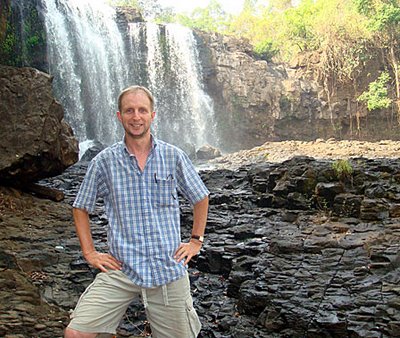 Not so beautiful - the author does his Khmer impression and has his photo taken with the falls as a backdrop
Not so beautiful - the author does his Khmer impression and has his photo taken with the falls as a backdrop The ten metre waterfall that greets you was indeed impressive and is even more memorable during the wet season, from the photos I have seen. Now in the height of the dry season, the water volume wasn't too great but was still enough to catch three Khmer women unawares the week before our visit and swept them to their deaths. So be warned. The rocky riverbed now provides a nice place to picnic before it tumbles over a much larger 25 metre drop to the floor of the valley below. There are steps leading down to the valley but they looked far too steep for me to attempt, so I contented myself with a few photos, a paddle in the refreshingly cold water and a chat with a few Khmers on holiday for the weekend from Phnom Penh.
After a drink with some of the stall-holders, who were cousins of Chen, we returned to Sen Monorom and a much smaller waterfall just a few kilometres outside of town. Its called Monorom Falls or Domnak Sdach (King's Resting Place) in Khmer. It's a five metre drop into a pool that is often frequented by young children who use the falls as their diving platform. Today there was no-one around except for workers from the hydro-electric power plant being built next door. Back in Sen Monorom, we had lunch at the So Paul restaurant, next to the Kouprey monument before Sokheng and Chen had to leave town to return to Khaosima, and I headed for another hot shower and rest.
More from the Mondulkiri tour
I took a spot, with my bike and the group's bags, in the rear of the back-up pick-up truck for the 40kms to Mereuch and arrived at 10am, spending the rest of the morning and afternoon, idling by the river. By late afternoon it was clear something had gone awry with the group and frantic communications between the Park Rangers at the HQ and the Ranger mahout on the elephant, indicated that the group had got lost in the forest and were in dire need of provisions. I forgot to mention that Mondulkiri's reputation for cooler weather was not applicable in the forest, where it was as hot as the city, so that merely added to the situation. The news got better when the group arrived at an outpost called Trapeang Chhouk but they were still four hours away from their intended destination and were mightily relieved to jump on board the pick-up truck that had been sent from Mereuch. They finally arrived, minus their bikes, an hour from midnight, exhausted, battered and bruised from their experience. My decision to take a raincheck on Day 2 had proved a good one.
Tour de Mereuch - part 2
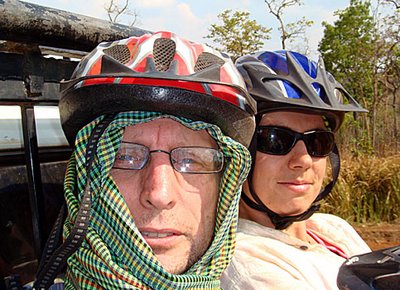 No its not Lawrence of Arabia...it's me on Day 4 in the back of the truck, again, this time with tour organiser, Olga van den Pol. I was too tired to take a picture at the end of Day 1!
No its not Lawrence of Arabia...it's me on Day 4 in the back of the truck, again, this time with tour organiser, Olga van den Pol. I was too tired to take a picture at the end of Day 1!The Tour de Mereuch bike tour had begun earlier in the day from the WWF office in Sen Monorom, the provincial capital. The plan was to cycle 76kms to the WWF/Srepok Wilderness Field Outpost at Trapeang Thmeir, inside the protected forest of Mondulkiri province. We started with eight cyclists and a support vehicle. Within ten minutes two cyclists had disappeared without trace and so had our back-up. We didn't see them again for another six hours. This was my first biking experience since I broke my arm in a cycling accident some 35 years ago - I should've seen the writing on the wall. For much of the route, the terrain wasn't too bad, bumpy and rutted yes but we were in Mondulkiri afterall, though it was the rolling hills for which the province is famous, that really broke my spirit. For experienced mountainbikers, hills aren't a problem, for me they were agony. I simply wasn't prepared for them, having cycled around Phnom Penh for a couple of weeks, where there isn't a hill in sight. I didn't have the power in my thighs and calves for the inclines and the steep declines were at times, pretty scary. The roads aren't paved, they are hard-packed red dirt roads that are rutted by trucks and motorbikes in the wet season and if you choose the wrong line to follow, it can be very costly.
After stopping at the village of Puchiri for sugar-cane juice and lunch, we finally caught up with the support vehicle and our two colleagues at another field outpost at Nam Ram. They'd actually got ahead of us when we took a cross-country diversion and had sped-on. Indeed, most of the group were experienced cyclists and I often found myself bringing up the rear, which is demoralizing enough for anyone. After six hours in the saddle, and some 72 of the 76 kilometres completed, I admitted defeat and dragged myself into the back of the support vehicle. I simply couldn't manage another inch. We reached Trapeang Thmeir just as the sun was setting, showered at the water-pump, had a bite to eat and fell into our hammocks hooked up under the Ranger Station. I had already decided that the cycling on Day 2 would begin without me.
Sunday, March 23, 2008
Tour de Mereuch - part 1
To be honest I am so knackered that I can hardly type! Here's a couple of photos from the first two days of the mountainbike tour. The story will follow when I've had some more rest.
Above is a picture of me outside our hotel in Sen Monorom before setting out on Day 1. If I knew then what I knew at the end of Day 1, I wouldn't be smiling - it was probably the most exhausting day of my life. I cycled in excess of 70kms on that first day, my first proper cycling experience in more than 30+ years. I'm pleased I made the trip but the cycling was much tougher than I, or anyone, expected. It was a unique introduction to my first view of Mondulkiri province, the protected forest we visited covers a huge part of the northeast section of the province and at its heart is the Srepok Wilderness area that is home to tigers, leopards, bears, gaur, banteng and rare birdlife. We stayed for three nights at two ranger stations in the forest (at Trapeang Thmeir and Mereuch) and got a taste of the potential for ecotourism activities that WWF are hoping to promote there. Below is the bike team at the start of Day 2. The photo was taken outside the Srepok Wilderness/WWF Field Outpost at Trapeang Thmeir and I'm taking the photo as I simply couldn't find the strength to start the second day - as it turned out, I am so glad I didn't make it. More of the details later.
A furry bear story
Wildlife conservationists in Cambodia on Wednesday opened Asia's first centre to preserve local bear populations, under severe threat from poachers and exotic pet traders. The Bear Discovery Centre hopes to promote awareness of the plight of Asia's bears, said Mary Hutton, chairwoman and founder of the Australia-based Free the Bears Fund Inc (FTB). "It is so important because not so many bears are left in the wild," Hutton told AFP, saying their population was declining, although it is impossible to know how many bears remain.
The Asiatic black bear and Sun bear, both found throughout the region, are considered vulnerable according to the World Conservation Union's Red List of threatened species. "There are not as many as there should be, and the Sun bears are on their way to becoming an endangered species," Hutton said, adding that there are currently 88 bears at Cambodia's Phnom Tamao Zoo, where the centre is based. According to the FTB, which says it has rescued more than 100 bears from the wildlife trade in Cambodia, the animals are hunted in large numbers throughout Southeast Asia to feed growing demand for their parts to be used in restaurants.
More than 14,000 bears are also thought to be kept on farms in China and Vietnam where their bile is extracted and used for traditional medicine. "This is a cruel and unnecessary practice, which should be replaced by modern medicine," FTB said. In other cases, adult bears are killed so that poachers can capture their cubs to sell to the exotic pet market, Hutton said. A similar centre is expected to open in Vietnam later this year in a bid to expand conservation efforts, she added. Bears are only one among many species of animals that have been decimated by Asia's wildlife trafficking, which is fueled in large part by China's massive appetite for exotic meats and other animal parts.
Sunday, March 16, 2008
The rolling hills of Ratanakiri
Time stands still in Lumphat
A week without blogging
Whilst I'm away I will miss a feast of films being shown at Meta House on Street 264 (near Wat Botum) as part of the CineMekong film festival. However last night I caught Nice Hat by David Brisbin and Ian White's Straight Refugeez. Two very different films - the former a fun look at Cambodia through the headwear of its people, the latter an insight into the convicted returnees from America. Tonight I will fit in 4 more films on the revival on Khmer arts. The session kicks-off at 7pm and will include John Bishop's Seasons of Migration. I did invite one of my friends, Sam Savin, who was one of the lead dancers in this contemporary dance piece but she's ill at the moment. Also showing tonight will be The Battle to Rebuild Sbaek Thom, A Reflection on Cambodian Contemporary Art and The Phnom Penh Video Art Project.
Out of the whole festival, which is also playing at the French Cultural Center and other locations, I really wanted to see Monday night's films, Kampuchea: Death and Rebirth and The Flute Player. The 80-minute Kampuchea film was made in the spring of 1979 as an East German film team filmed the first scenes after the fall of the Khmer Rouge regime. I expect it to be very moving. The Flute Player is the story of Arn Chorn-Pond, who has done a fantastic job in founding Cambodian Living Arts. I've met the inspirational Arn but I still haven't seen the documentary about him by Jocelyn Glatzer. A variety of films about Cambodia will be shown every night next week, so get along to Meta House and take a look for yourself.
Just back home from Meta House and particularly the Seasons of Migration film. It was great to see my friend Savin performing the traditional-cum-contemporary dance piece; she's closest to the camera on the left-hand side of the picture below, just a real shame she couldn't see the film tonight as she's not well. It was filmed in 2005 when Savin and the dance troupe were touring the United States.
Saturday, March 15, 2008
Wat Nokor's Preah Noreay
Above is a 4-armed version of Preah Noreay to be found opposite the 8-armed version just inside the inner entrance at the eastern gateway to Wat Nokor. A large club is the only weapon held by this statue, which again is a mix of original sandstone and concrete repairs. At the foot of the statue are small naga antefixes which usually sit on the upper levels of the temple's towers. Below is a modern Buddhist altar in one of the small side buildings on the northern section of the complex. In front of the Buddha is a small inscription stone from Angkorean time.
Carvings galore
The above representation of The Great Departure by Prince Siddhartha on his mighty horse, attended to by members of his court carrying parasols and worshippers can be found on the northern face of the eastern gopura as you enter the complex. The southern pediment of the same gopura is in danger of imminent collapse. The gopura below is at the western end of the complex and contains the two Lokeshvara pediments shown above. Although the farthest from the entry point, its well worth viewing for its excellent carvings and devatas in niches.
More from Wat Nokor
Above is the eastern gopura of the third enclosure, the outer entrance to Wat Nokor. Most of the gopuras and gateways contain carvings of devatas and other iconography and it's worth scrabbling around the fallen stones to look for some hidden gems. Below, this royal pool is located on the southeast corner of the complex and its original sandstone structure is mainly still in place.
Friday, March 14, 2008
Loch Mao in the frame
Khmer Rouge defector named as Briton's killer - by Tom Fawthrop, Sunday Times, 14/06/1998
Scotland Yard detectives investigating the murder of Christopher Howes, the British mine clearance expert, by the Khmer Rouge, have been told that the killer was a former guerrilla commander who has since defected to the Cambodian army. A witness who took the detectives to the murder scene has claimed that Howes, 37, from Bristol, was shot by Loch Mao, an officer in the former Khmer Rouge stronghold of Anlong Veng.
Howes was taken to a school at Anlong Veng, where he is said to have been interrogated by General Khem Nguon, the Khmer Rouge’s deputy chief of staff. According to Nget Rim, 48, the general’s chief bodyguard, Howes was killed shortly afterwards. He said Mao, sitting behind Howes, pulled out a Chinese-made .54 calibre pistol, firing once in to the back of his neck without warning, and once into his back. It is understood that Mao has been identified as the killer by at least two other witnesses, including the general’s driver. The witnesses accompanied detectives and George Eggar, the British ambassador in
The Great Departure
The rather worn lintel below the pediment shows a grinning kala topped by more figures but it's difficult to identify the features. The bottom photo in this sequence is from the northern gopura of the first enclosure which has a well-defined pediment with a two-armed Lokeshvara standing between two kneeling figures, over a register carved with seven worhsippers holding two lotuses each. The destroyed lintel below has five niches with defaced Buddhas.
Flashback in time
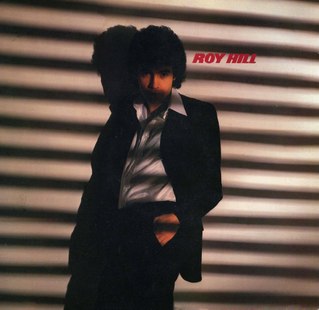 Who is this suave, debonair, camp-looking chap you ask? Well, it's none other than the legendary Roy Hill - well, maybe legendary is a bit too strong! In 1978 Roy produced his one and only solo album, (un)imaginatively entitled Roy Hill and this is the cover photo of Roy looking very seductive (according to Roy). Honestly, he should've been a big star, believe me I know my music! But like so many, his solo career was but a brief flash of brilliance and then he disappeared, quite literally, from my radar. Well, I can now be transported back to those heady days with the release of two CD's by the man himself, that should be available anytime soon. So he tells me. But I'm sure he's told me this before. Anyway, when I get the details of how to purchase them, I'll let you know.
Who is this suave, debonair, camp-looking chap you ask? Well, it's none other than the legendary Roy Hill - well, maybe legendary is a bit too strong! In 1978 Roy produced his one and only solo album, (un)imaginatively entitled Roy Hill and this is the cover photo of Roy looking very seductive (according to Roy). Honestly, he should've been a big star, believe me I know my music! But like so many, his solo career was but a brief flash of brilliance and then he disappeared, quite literally, from my radar. Well, I can now be transported back to those heady days with the release of two CD's by the man himself, that should be available anytime soon. So he tells me. But I'm sure he's told me this before. Anyway, when I get the details of how to purchase them, I'll let you know.So what do these CD's contain? First up will be Hello Sailor, a collection of songs recorded way back in the late 1970s. Some tracks are acoustic demos, others were recorded with The Strolling Players, a bunch of musicians from Cheltenham where he lived at the time. The tracks on Hello Sailor, guaranteed to take me on a nostalgic journey, are:
Join Me; Get To the Lieutenant; George's Bar; Down In The Cellar; The Boys Would Like You To Know; Keep Way From Me; I Try Not To Hear; More; Window; Piccadilly Lights; Watching The Diamond Disappear; Singing At The Wheel.
Man Overboard; Jenny Takes A First Look At Life; Don't Leave Me Here; Every Single Time; The Man To Blame; Sleeping With Ghosts; Superheroes; Falling; Without Eddie; Small Adventurer; Marion Jones; It Just Might Happen.
To get a clearer picture of the man himself, I suggest you frequent his new MySpace website here. You won't regret it.
Did you think I'd forgotten?
The bottom two Neak Ta are slightly different. The top one is a Neak Ta containing ancient and revered stones and the heads from broken statues at Wat Prei Puoch. The powerful Neak Ta spirits are located where the locals believe their powers and energy force will do most good. The shrines or huts of Neak Ta literally contain anything, natural or man-made - the objects representing the land, water and spirit elements. The bottom Neak Ta is of a wise gentleman and the shrine also houses some ancient stones and a seima stone from the pagoda itself. The pagoda of Wat Khpop is an old brick-built and wooden construction next to a river, which is being replaced by a modern vihara about half a kilometre away.
Whilst I'm posting, I just wanted to say a big thank you for the messages of support I've received since I broke the news that my original blog had been stolen. I'm quite overwhelmed by the show of support for my blog, and its nice to know that it's being read on a regular basis by a wide range of people.
Seeking solitude
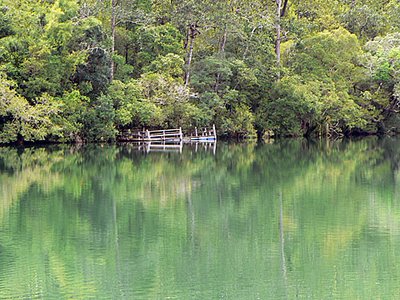 If you are looking for peace and solitude on a trip to Ratanakiri, then head 70kms east of Ban Lung, the provincial capital and aim for Lumkut Lake. At the weekend, you might a few locals joining you for the beauty and peacefulness of this lake but most likely, you'll be there to enjoy it all by yourself. Its actually larger in size than the more popular Yeak Loam Lake, just outside of Ban Lung, but the road to Bokheo can be treacherous and impassable, particularly during the wet season, and until they upgrade the road (which they are doing now), a dry season trip is your best bet. There is a trail around the lake but its no more than that, and certainly cannot be called a path, so be prepared, its an attraction that is still in its pristine and virgin state. It's more than sixty metres deep in places, is oval in shape and believed to be a volcanic crater in origin.
If you are looking for peace and solitude on a trip to Ratanakiri, then head 70kms east of Ban Lung, the provincial capital and aim for Lumkut Lake. At the weekend, you might a few locals joining you for the beauty and peacefulness of this lake but most likely, you'll be there to enjoy it all by yourself. Its actually larger in size than the more popular Yeak Loam Lake, just outside of Ban Lung, but the road to Bokheo can be treacherous and impassable, particularly during the wet season, and until they upgrade the road (which they are doing now), a dry season trip is your best bet. There is a trail around the lake but its no more than that, and certainly cannot be called a path, so be prepared, its an attraction that is still in its pristine and virgin state. It's more than sixty metres deep in places, is oval in shape and believed to be a volcanic crater in origin.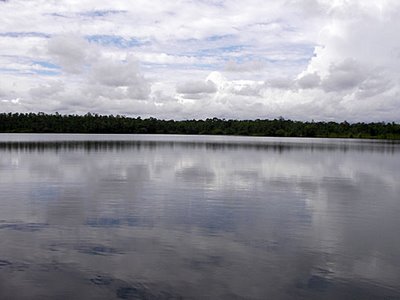
Fun with learning
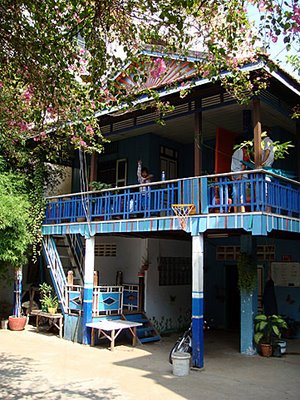 The play area in front of the main Aziza's Place building, with the open-air classroom on the balcony
The play area in front of the main Aziza's Place building, with the open-air classroom on the balconyA quick update
I received the schedule for my Mondulkiri WWF Bike Tour yesterday and for an unfit person like myself, I am seriously going to regret saying that I would join in! I just know it. We are literally cycling through and around the Mondulkiri Protected Forest, stopping overnight at 'field outposts' which in anyone's language sound less than comfortable and we'll be hours from civilization. I can't find the names of Trapeang Thmier, Trapeang Chhouk, Mereuch, O'Rovei and Dei Ey on any map, and the suggestion that I bring along oral rehydration packs such as Camelbak don't augur well. On day three we take a boat ride and a walking trip to give my legs a rest from cycling but aside from that it'll be on the bike in the heat and humidity of a forest - I'm looking forward to seeing Mondulkiri for the first time, with a free day in Sen Monorom tagged onto the end, but the battering my body is going to take is the bit I'm not so keen on.
Thursday, March 13, 2008
Ratanakiri re-visited
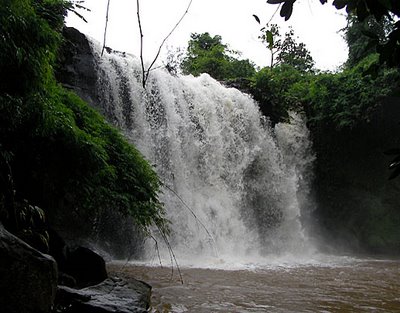 The gorgeous waterfall at Ka Chanh, some 9kms from the provincial capital of Ratanakiri called Ban Lung. Alongwith Cha Ong and Katieng, its one of three waterfalls that attract a lot of tourists, both international and Khmer, to the area
The gorgeous waterfall at Ka Chanh, some 9kms from the provincial capital of Ratanakiri called Ban Lung. Alongwith Cha Ong and Katieng, its one of three waterfalls that attract a lot of tourists, both international and Khmer, to the area 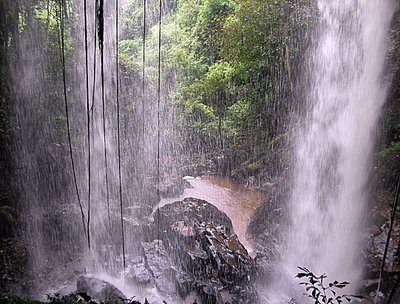 This waterfall is called Cha Ong, a few kilometres outside of Ban Lung and it's one of the most popular waterfalls visited by tourists to the area. It's in a lovely setting, with the water cascading down into a beautifully-forested gorge at the bottom. You can clamber behind the waterfall - where this picture was taken - but the rocks can be very slippery and losing your footing isn't recommended. There's a 2,000 Riel entrance fee for foreigners at all waterfalls.
This waterfall is called Cha Ong, a few kilometres outside of Ban Lung and it's one of the most popular waterfalls visited by tourists to the area. It's in a lovely setting, with the water cascading down into a beautifully-forested gorge at the bottom. You can clamber behind the waterfall - where this picture was taken - but the rocks can be very slippery and losing your footing isn't recommended. There's a 2,000 Riel entrance fee for foreigners at all waterfalls.Wednesday, March 12, 2008
Kong Vong Thom
Dr Benny tells it like it was
Gecko success
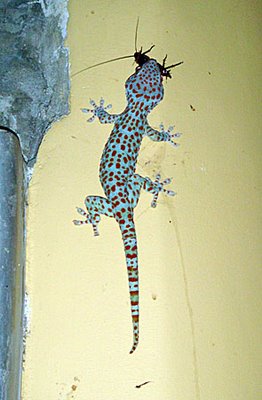 This is Sunny, the rather large Tokay Gecko that has a home on the wall next to the entrance to the Rising Sun pub just a few steps away from the riverside and FCC. He's to be found on the wall most nights, lying in wait for unsuspecting visitors. Usually he's partial to roaches, crickets, mozzies and the like but there's a story that if he jumps on your neck, it's a bad sign! That was the story a Khmer friend related to me and I cracked up. Yes indeed, if Sunny was to land on your neck you would be in trouble! It's difficult to see from the photo, but this gecko is a big one, believe me. Make sure you say hi to Sunny and the staff including Samnang and Thida next time you are passing the Rising Sun, which I always visit at least once a week to sample the excellent food they put on. The music leaves a bit to be desired but the fare far outweighs the sounds.
This is Sunny, the rather large Tokay Gecko that has a home on the wall next to the entrance to the Rising Sun pub just a few steps away from the riverside and FCC. He's to be found on the wall most nights, lying in wait for unsuspecting visitors. Usually he's partial to roaches, crickets, mozzies and the like but there's a story that if he jumps on your neck, it's a bad sign! That was the story a Khmer friend related to me and I cracked up. Yes indeed, if Sunny was to land on your neck you would be in trouble! It's difficult to see from the photo, but this gecko is a big one, believe me. Make sure you say hi to Sunny and the staff including Samnang and Thida next time you are passing the Rising Sun, which I always visit at least once a week to sample the excellent food they put on. The music leaves a bit to be desired but the fare far outweighs the sounds.
Tuesday, March 11, 2008
Re-post: Behind the headlines - Khem Nguon
 Sometime in the next couple of months, I expect the court case of Khem Nguon to come up in front of the Phnom Penh Municipal Court as he was arrested and held for six months pending his trial back in November 2007. I have been following the plight of Christopher Howes, for which Nguon is charged with his murder with two others also held in detention, since he disappeared in March 1996 and now that the appetite to try those responsible is evident, it is time that justice for Christopher and his interpreter is found. Below I have re-posted a blog posting from 21 November 2007 to give you the background on the man alleged to have been responsible for Christopher's death.
Sometime in the next couple of months, I expect the court case of Khem Nguon to come up in front of the Phnom Penh Municipal Court as he was arrested and held for six months pending his trial back in November 2007. I have been following the plight of Christopher Howes, for which Nguon is charged with his murder with two others also held in detention, since he disappeared in March 1996 and now that the appetite to try those responsible is evident, it is time that justice for Christopher and his interpreter is found. Below I have re-posted a blog posting from 21 November 2007 to give you the background on the man alleged to have been responsible for Christopher's death.21 November 2007: Khem Nguon was charged last week by the Phnom Penh Municipal Court with the kidnapping and murder in 1996 of Christopher Howes, a British de-mining expert from Bristol in Southwest England, working in Cambodia with the Mines Advisory Group. Howes and his interpreter Houn Hourth were captured by Khmer Rouge guerrillas in a remote village in Siem Reap province in March 1996, transferred to the KR stronghold of Anlong Veng and murdered. Though Nguon denies his involvement, it’s alleged that he supervised the killing on the instructions of his commanding officer, the brutal one-legged Ta Mok. Arrested alongwith Nguon were Loch Mao, a CPP-affiliated district official in Anlong Veng, who is alleged to be the man who pulled the trigger, and Chep Cheat, believed to be their driver. Further suspects are also being sought.
I’ve peered into the murky world of the Khmer Rouge to try to find out more about Khem Nguon but as you might expect, permeating a guerrilla organization isn’t easy sat at a desk and hard-line fighters don’t as a rule issue detailed biographies. However, Nguon, 58, originally from Takeo province, joined the Khmer Rouge movement in the ‘60s and was a Ta Mok loyalist from the days when ‘The Butcher’ ran the Southwest Zone with an iron fist. After the Khmer Rouge captured Phnom Penh in April 1975, Nguon served in the Military Division 502, an air-force unit. Later, he was sent to Shanghai in China for three years of military training specializing in radar, air-strikes and artillery. In an interview with the Phnom Penh Post in 1998, Nguon said he did not return to Cambodia until after the 1979 ousting of the Khmer Rouge by the invading Vietnamese when he joined Ta Mok’s forces at their Anlong Veng base in northwest Cambodia as the Chief of Military Division 980.
During 1997 and 1998, Nguon was a key player and very vocal in the internal drama within the Khmer Rouge leadership over the control of the movement. After Pol Pot had his Defense Minister Son Sen and his wife Yun Yat executed in June 1997 over their alleged secret negotiations with the Phnom Penh government, Ta Mok with Nguon, as his chief lieutenant, arrested Pol Pot alongwith senior cadre, Saroeun, San and Khan. The resultant show-trial of Brother Number One was held on 25 July 1997 and all four were convicted of betraying the movement; Pol Pot was placed under house arrest, the other three cadres were executed. At the time, Nguon courted the media and told reporters he had destroyed Pol Pot and rid the world of a tyrant. After Pol Pot’s death in April 1998, Nguon said he had hoped to hand over Pol Pot to a war crimes tribunal but he’d died of a heart attack. His quote at the time was; “What I can tell you is that he was quite old and he dropped his life like a ripe fruit.”
Just days later, he was again in the news when he announced he’d replaced his long-time mentor Ta Mok as commander of the Khmer Rouge, had changed their name to the National Solidarity Party and was making peace overtures to the Cambodian government, citing; “…to bring about national reconciliation where all parties announce an end to the war which no one has won, no one has lost.” With the Khmer Rouge in their final death throes, Nguon and half a dozen military generals finally surrendered to the Cambodian government on 6 December 1998 in exchange for amnesty and exemption from prosecution. He said he brought with him 5,000 troops and 15,000 civilians living under KR control. However, less than a month later he was threatening a resumption of hostilities if attempts were made to arrest other former Khmer Rouge leaders. It seems Khem Nguon had a quote for most occasions and a hot-line to the world’s press around that time. He’s been conspicuously silent in more recent years.
A part of Nguon’s amnesty was the award of a position as Brigadier-General in the Royal Cambodian Armed Forces, acting as an advisor to the defence ministry. One of his most recent responsibilities with the RCAF was to participate in the military commission tasked with resolving border issues with Thailand. He speaks Chinese, Thai and reasonable English and has been living in Phnom Penh until his arrest. In an interview with the Phnom Penh Post in 1998, Nguon claimed he was not present at the shooting of the British de-miner, though he had spoken to him before his death, the shooting was ordered by Pol Pot and supervised by Saroeun, one of the cadres tried and executed after the Pol Pot show-trial. However, eyewitness testimony provided to British police detectives tells a different story. It alleges that Howes was shot from behind on the order of Ta Mok and his deputy Khem Nguon, who supervised the killing and was the last one to speak to him. The Scotland Yard report named those responsible as Ta Mok, Khem Nguon, Colonel Kong, the cadre who pulled the trigger and three members of Nguon’s bodyguard unit, known only as Rim, Lim and San.
Until now, the Cambodian authorities have not had the appetite to arrest the men responsible, despite lobbying from the former British Ambassador Stephen Bridges that resulted in deputy prime minister Sar Kheng saying that any prosecution must wait until the time was right. That time arrived last week and Khem Nguon is now in custody awaiting trial, alongwith two Khmer Rouge cohorts. If found guilty, the men face sentences of between 10 and 20 years imprisonment.
For more on Christopher Howes, please visit my website here. Photo courtesy of Phnom Penh Post.
Warning - My Blog was Stolen!
if you are reading this message, then you have most likely already located the home of my new Blog. You are very welcome.
About 3 weeks ago my passwords were stolen by a computer hacker who hijacked my Blogger.com identity and took control of the Blog that I have been updating daily for the last 21 months. As you can imagine I was distraught.
I have now set up this new Blog under the umbrella of my website and will cut & paste the last 21 months worth of postings over the next few weeks.
Please remove your bookmark to my old Blog site at andybrouwer (dot) blogspost (dot) com.
And a word of warning, don't fall into the same trap as me and click on innocent-looking links - because you don't know what's behind it! Be Smart, Be Net-Wise!
Andy
http://andybrouwer.co.uk/blog/
Meagre remains at Ang Reaksmei
The bottom photo is of the broken bricks and sandstone pedestals that constitute the remains to be found at Neak Ta Ang Kambot Ka, a ten minute walk from the village across a series of dried-out rice fields. The mound and large holes in the ground suggest to me there were three brick structures in its original form but the site has been completed devastated, like so many others, that's its almost impossible to tell without a detailed investigation by experts. And I am no expert. Whenever I encounter a site like this I see what I can find at the center of the site and then work outwards to see if anything else of interest or value is lying in the surrounding bushes or undergrowth. No doubt the villagers who took me to the site likely thought I was just another crazy barang - though I was the first that had visited the site as far as they knew - but the combination of old sites like this and meeting real Cambodians far off the beaten track is my ideal Sunday excursion. Oh I nearly forgot, they also told me that Ministry of Culture officials had visited the site a few years before and taken away an inscription stone with "old writing" on it, and they only took me to the site because I promised I wasn't going to steal anything!
Forgotten sites
The picture below was taken at the site of three pre-Angkorean brick temples called Neak Ta Ang Kambot Ka that have long since been reduced to rubble and are almost unrecognisible amongst the thorn bushes and paddy fields. I called into the village of Ang Reaksmei to find the location of the site amongst the rice fields and was immediately surrounded by a large group of villagers, mostly women and children, eager to find out why I was there. Two of the older women in the photo, Omron and Ommak, were happy to lead me across a series of dykes to a small rise in the middle of the fields that housed the former temple site. Amongst scattered bricks and three large excavated holes, there was little to see except three large sandstone pedestals, so dating the site was impossible and my guides told me that the temples had been in this state for as long as they could remember. They also said that two more Ang - a small hill containing something of archaeological interest - were closeby, though this was the 'best' of the three. I returned to the village and walked to Neak Ta Ang Tros to confirm their evaluation. This former prasat was another brick construction and a small shrine housed some slate and sandstone fragments but nothing else. Nearby, Tuol Ang Theat contained even less. After thanking my temporary hosts, I left the village of Ang Reaksmei on my search for more rubble-strewn sites!
Monday, March 10, 2008
Jenta assumes top spot
 This is Ping Jenta, who on the 29th of this month will be appointed head monk at the pagoda of Wat Ang Popeay Meanchey, approximately 10kms south of Ang Snuol, a dusty town on the main highway between Phnom Penh and Kompong Speu. Jenta is 33 years old and speaks very good English, having travelled widely, including Paris, Kuala Lumpur and Singapore, and has the healing powers of a doctor, according to one of the wat's committee members. I met him on Sunday when I stopped by his wat to look for some sculpture fragments, which he proudly showed me and which include a sandstone pedestal. He was planning his big day with members of the committee but was more than welcoming with hot tea and ice-cold water offered before I even sat down. Born in the village next to the pagoda, Jenta is extremely proud to become the head monk and was quick to invite me to the ceremony, that will be presided over by an array of big-wigs from Phnom Penh. He has thirty monks at his pagoda, which was originally built in 1820 but was burnt down in the civil war and strife of the 1970s. It was the first stop on my Sunday jaunt west of Phnom Penh, to be followed by two more wats and five other sites that previously housed pre-Angkorean brick-built prasats. No earth-shattering discoveries but some nice moments to remember, like my meeting with Jenta, the new head monk.
This is Ping Jenta, who on the 29th of this month will be appointed head monk at the pagoda of Wat Ang Popeay Meanchey, approximately 10kms south of Ang Snuol, a dusty town on the main highway between Phnom Penh and Kompong Speu. Jenta is 33 years old and speaks very good English, having travelled widely, including Paris, Kuala Lumpur and Singapore, and has the healing powers of a doctor, according to one of the wat's committee members. I met him on Sunday when I stopped by his wat to look for some sculpture fragments, which he proudly showed me and which include a sandstone pedestal. He was planning his big day with members of the committee but was more than welcoming with hot tea and ice-cold water offered before I even sat down. Born in the village next to the pagoda, Jenta is extremely proud to become the head monk and was quick to invite me to the ceremony, that will be presided over by an array of big-wigs from Phnom Penh. He has thirty monks at his pagoda, which was originally built in 1820 but was burnt down in the civil war and strife of the 1970s. It was the first stop on my Sunday jaunt west of Phnom Penh, to be followed by two more wats and five other sites that previously housed pre-Angkorean brick-built prasats. No earth-shattering discoveries but some nice moments to remember, like my meeting with Jenta, the new head monk.
The final KR Legacy forum
I am knackered...
Saturday, March 8, 2008
Cycling hell
The audience numbers were a little better this week for tonight's screening of Inside Pol Pot's Secret Prison, a 2002 American History Channel production that provided a look behind the barbed wire of Tuol Sleng. Interviews with survivors Vann Nath and Chum Mey, alongwith former S-21 guards, interrogators and photographer Nhem En formed the crux of the story of Pol Pot's infamous prison where more than 14,000 people were imprisoned, tortured and killed. Adding weight to the programme was David Chandler, David Hawk, Youk Chhang and Nate Thayer together with a series of fuzzy reconstructions and rare film footage. Afterwards at the Rising Sun, I met Mariam Arthur for the first time after a series of emails over the last few years. Mariam is doing her bit for the Cambodian film industry and founded the NGO Film Cambodia Organization in January. She has been producing the film trade magazine Mise en Scene since June 2007.
What's CCBEN?
 CCBEN - Cambodia Community-Based Ecotourism Network - is a network of thirty or so institutions involved in or supporting community-based ecotourism in Cambodia that meets quarterly with the aim of protecting the natural and cultural resources of the country and raising the living standard of the local communities that are involved in ecotourism projects. It's been going since 2002 and is involved in information exchange and networking, local capacity building, tourism research, and the marketing and promotion of various destinations. As ecotourism becomes increasingly sexy to a more-demanding tourist population, more projects will be added to the existing menu of CCBEN supported sites that currently exist.
CCBEN - Cambodia Community-Based Ecotourism Network - is a network of thirty or so institutions involved in or supporting community-based ecotourism in Cambodia that meets quarterly with the aim of protecting the natural and cultural resources of the country and raising the living standard of the local communities that are involved in ecotourism projects. It's been going since 2002 and is involved in information exchange and networking, local capacity building, tourism research, and the marketing and promotion of various destinations. As ecotourism becomes increasingly sexy to a more-demanding tourist population, more projects will be added to the existing menu of CCBEN supported sites that currently exist.These are: the bird sites at Ang Trapeang Thmor, Prek Toal and Tmatboey; the two Ratanakiri sites at Yeak Laom and Virachey National Park; Banteay Chhmar; Chambok in Kompong Speu; Koh Pdao on the Mekong River and Kompong Phluk. These initiatives are now well-established and will soon be joined by new projects being undertaken at Prek Tnout near Kampot by Save Cambodia's Wildlife, in the Cardamon mountains at Chipat by Wildlife Alliance and the WWF-supported Mondulkiri Protected Forest. The latter project is one that I'm visiting on the 17th of this month to partake in a four-day bicycle adventure tour in a remote region of this northwest province. At the same time, the Mekong River Discovery Trail project will be hosting a tour of its range of proposed products - cycling, homestay, kayaking, bird-watching, and more - along the Mekong River between Kratie and the Laos border.
These projects are designed to increase the range of options for tourists wishing to do more than visit the original options of temples, beaches and city tours. They will bring tourism to parts of Cambodia that have been starved of participation in this booming industry and they will add a variety of experiences that will keep tourists in Cambodia for longer. CCBEN and its members are playing a vital role in promoting this new and exciting chapter of tourism in Cambodia. Link: CCBEN.
Looking ahead
The sixth and final Khmer Rouge Legacy public forum will be held this coming Monday (10 March) at Pannasastra School on St 370. It's title is People's Involvement since 2003 and will discuss participation by the public and grassroots NGO/outreach involvement in the Khmer Rouge Tribunal. The speakers will include Dr Kek Galabru, one of the leading human rights advocates in Cambodia. Ray Leos will moderate. These forums have been instigated by Meta House and supported by the Konrad-Adenauer Foundation to shine a light on the history of the Tribunal now underway and to bring it into a context which can be easily understood.
Later in the month, on 27 March, a film that has been 20 years in the making will be shown at Chaktomuk Theatre in a ceremony to be presided over by Deputy Prime Minister Sok An. Stanley Harper’s movie Cambodian Dreams documents the parallel stories of rural farm grandmother Yan Chheing's struggle in a refugee camp in Thailand, and her daughter’s hard life in the rice fields of Cambodia. It will air on all national TV stations simultaneously.
Friday, March 7, 2008
Em Theay - a national icon
Here's a post from September 2006: After posting the Beyond the Killing Fields blog entry yesterday, I recalled that Em Theay was the main subject of a documentary I watched many years ago called The Tenth Dancer, which focused on the strength and resilience of the women of Cambodia in rebuilding their traditions from the fragments of a shattered society. The Khmer Rouge were responsible for the death or disappearance of over 90% of Cambodian artists, including most of the dancers of the Royal Ballet. Theay was one of the 10% to survive. The Tenth Dancer was made as long ago as 1993. Em Theay is still dancing and teaching today and performing abroad at the age of 75 years old - by anyone's reckoning that is a remarkable story.
Em Theay was chosen to dance at the age of seven by Queen Kossomak, for whom her parents worked as domestic servants. She grew up in the Royal Palace and was a dancer and singer in King Sihanouk's Royal Ballet until the Khmer Rouge took over her country. At that time she was forty-three and was sent to live in Battambang, where her talents didn't go unnoticed and her captors encouraged her to sing and dance as well as work in the fields. In 1975, twelve of her 18 children were alive. By the end of the KR period, seven had died and only five were left. Em Theay returned to Phnom Penh where her knowledge and skills of the traditional arts were put to use as a teacher at the National Dance Theatre and the Royal University of Fine Arts until quite recently. She is a vital link to Cambodia's past, quite literally a living national treasure and one that Cambodia should be tremendously proud of.
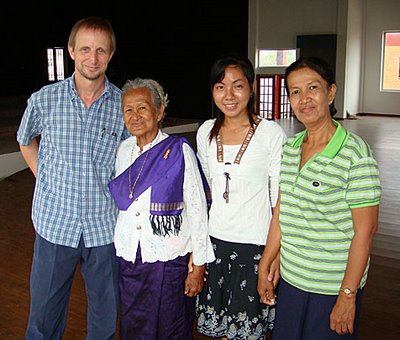 LtoR: The author, Em Theay, Priya and Thong Kim Leng
LtoR: The author, Em Theay, Priya and Thong Kim LengThursday, March 6, 2008
Film cameraman - yeah right!
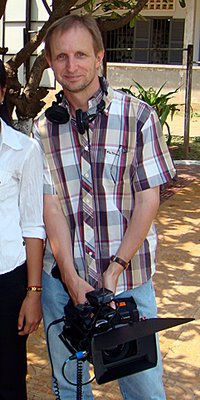 Who am I trying to kid? I just get to hold this very expensive and state of the art filming equipment - I have absolutely no idea how it works. I'm pictured at Tuol Sleng having just completed a couple of hours of filming Vann Nath's return to his former jail as part of a documentary on Cambodia, thirty years after the Khmer Rouge, by director Tim Sorel. Tomorrow morning we change the location to the new National Theatre to record an interview with the legendary Tenth Dancer, Em Theay. In preparation for the interview, I recently met Theay's daugher Thong Kim Ann, who also happens to be one of Cambodia's best classical dancers. Theay is a living embodiment of Cambodia's cultural past and in my view a national treasure. All of her children and her children's children have become performers, to carry on the example set by this incredible woman. I'm looking forward to meeting her tomorrow. It's pouring with rain outside at the moment - very unusual for this time of year - so let's hope that it's nice and dry in the morning.
Who am I trying to kid? I just get to hold this very expensive and state of the art filming equipment - I have absolutely no idea how it works. I'm pictured at Tuol Sleng having just completed a couple of hours of filming Vann Nath's return to his former jail as part of a documentary on Cambodia, thirty years after the Khmer Rouge, by director Tim Sorel. Tomorrow morning we change the location to the new National Theatre to record an interview with the legendary Tenth Dancer, Em Theay. In preparation for the interview, I recently met Theay's daugher Thong Kim Ann, who also happens to be one of Cambodia's best classical dancers. Theay is a living embodiment of Cambodia's cultural past and in my view a national treasure. All of her children and her children's children have become performers, to carry on the example set by this incredible woman. I'm looking forward to meeting her tomorrow. It's pouring with rain outside at the moment - very unusual for this time of year - so let's hope that it's nice and dry in the morning.
Feedback for Angkor National Museum
My trip report from January 2008 (re-post):
Saturday afternoon was my first opportunity to visit the new Angkor National Museum, which opened its doors to visitors in November. I must concur with previous reports that the museum is well presented using state-of-the-art technology with collections themed by temples, kings, beliefs and religions. The Gallery of 1,000 Buddhas is particularly striking and all the main collections include interactive multimedia presentations. However, the stylish presentations can't hide the fact that that the overall collection is way short of the quality to be found in the National Museum in Phnom Penh. It's also pretty small by comparison though that's deftly disguised through the technology and presentation. Entry is $12 per foreigner, $3 for Khmers, which is very expensive when compared with the museum in the capital or the Temples of Angkor. My view - an interesting addition to the range of visitor attractions in Siem Reap and an informative introduction to the Angkor story, but its over-priced and crying out for a bigger collection. I didn't have time to visit the attached shopping gallery, so can't comment on that. The museum covers 20,000 sq metres and has attractive water features including a pond at its center. A $2 camera fee will allow you to take photos in the public areas, so you can snap away at a few lions, heads from Angkor Thom and Preah Khan and a few other pieces of sculpture but cameras are not allowed in the main collections. I was disappointed that 40% of the items on display do not have any signage or explanation of their provenance, whilst the lighting on some exhibits could be improved. The galleries of inscription stele and lintels were quite poor and I have seen much better examples myself in the storage areas of Angkor Conservation. I loved the 1,000 Buddhas gallery though, with the walls inlaid with small back-lit Buddhas and larger items including the highly-unusual Sumethabos, a 9th century prostrate Bodhisattva from Phnom Vak, presented in the middle of the room. I'm glad I went but there's work still to do to bring it up to an acceptable standard for the price they are charging.
Roy Hill on MySpace
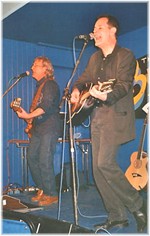 Guess who's been in touch....Roy Hill no less. Yes, I can hardly believe it myself, he's a virtual recluse! The man himself is Roy Hill, the ultra-talented singer-songwriter who made a massive impression on me, musically, back in 1978. Then, for me, he completely disappeared off the radar, until 26 years later. In the intervening years, whilst I was busy listening to Steel Pulse, Ennio Morricone, Billy Bragg and so on, Roy had licked his wounds after a bloody nose from his unfulfilled solo career to rise again in the guise of Cry No More, who for a decade wowed audiences in stockbroker-belt SE England, and beyond. My re-introduction to seeing Roy in the flesh again, accompanied by his straightfaced sidekick Chas Cronk, in the form of Cry No More was a revelation. Roy has matured his boyish charm and comic monologues into the funniest music set I’ve ever seen. He is simply brilliant.
Guess who's been in touch....Roy Hill no less. Yes, I can hardly believe it myself, he's a virtual recluse! The man himself is Roy Hill, the ultra-talented singer-songwriter who made a massive impression on me, musically, back in 1978. Then, for me, he completely disappeared off the radar, until 26 years later. In the intervening years, whilst I was busy listening to Steel Pulse, Ennio Morricone, Billy Bragg and so on, Roy had licked his wounds after a bloody nose from his unfulfilled solo career to rise again in the guise of Cry No More, who for a decade wowed audiences in stockbroker-belt SE England, and beyond. My re-introduction to seeing Roy in the flesh again, accompanied by his straightfaced sidekick Chas Cronk, in the form of Cry No More was a revelation. Roy has matured his boyish charm and comic monologues into the funniest music set I’ve ever seen. He is simply brilliant.Anyway, back to his latest email. Roy has all but completed his first two cd releases of a smorgasbord of delights that he's gearing up to release on the unsuspecting public. In addition, you can find out much more about Roy and his own unique style of music and wit at his new MySpace website. Click here.
Now, if I tell you what Roy’s plans are, then hopefully that will be an additional prod to make him complete the mammoth task he’s set himself. He’s currently putting all six Cry No More albums onto cd’s with his own inspired artwork, as well as compiling a dvd to be called The Cry No More Story, which will include clips from old vcr tapes, videos from three recent compositions and narration from Roy himself. If that’s not enough to whet your tastebuds, he’s also clicking into gear with his own stuff too. He’s nearly completed those first two releases I mentioned: Hello Sailor – very early tracks recorded before he signed to Arista in 1976 – and Fun With Dave – 12 songs recorded with Dave Richards in Switzerland during the early ‘80s. The target he’s set himself is ten releases in all, fifteen if he includes “the real rubbish!” If all that comes to fruition, I beseech everyone to buy the whole set. You will love it, I promise. My decision to relocate to Cambodia has some drawbacks to it, one of them is missing the annual live Cry No More Christmas extravaganza. Link: Roy Hill.
Wednesday, March 5, 2008
Sleeping women at Wat Nokor
The gopuras of the first enclosure at the temple also boast some neat carving. The western gopura depicts an incomplete pediment showing the bodhisattva being tortured in the top register. In the middle, a little man appears holding a stick amongst worshippers. In the worn lintel below, worshippers pay homage to Buddha.
Tuol Sleng snaps
Vann Nath revisits Tuol Sleng
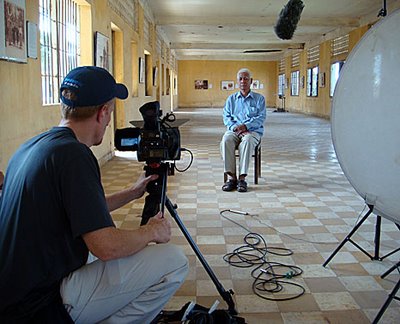 Director and cameraman Tim Sorel setting up the interview shoot with Vann Nath
Director and cameraman Tim Sorel setting up the interview shoot with Vann Nath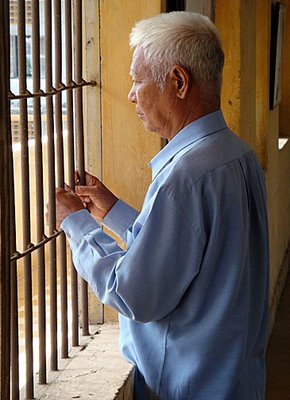 Vann Nath peering through the barred windows of the 2nd floor of Building B
Vann Nath peering through the barred windows of the 2nd floor of Building BTuesday, March 4, 2008
Wat Nokor in detail
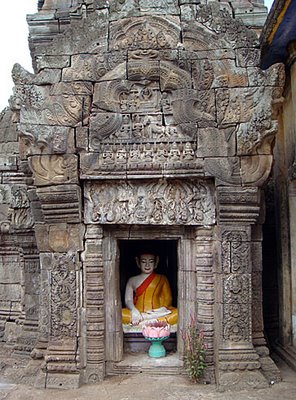 The southern doorway and pediment at Wat Nokor's inner sanctuary
The southern doorway and pediment at Wat Nokor's inner sanctuary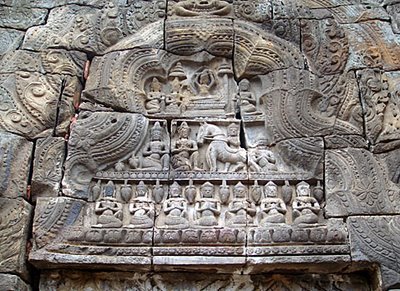 The hair-cutting and horse release pediment of the southern doorway
The hair-cutting and horse release pediment of the southern doorway Hope for Friends
Ancient and modern Neak Ta
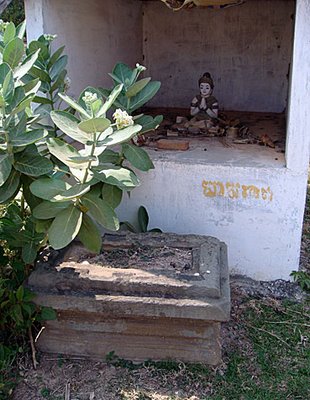 Nice combination: small Neak Ta figure and ancient sandstone pedestal at Wat Chum
Nice combination: small Neak Ta figure and ancient sandstone pedestal at Wat Chum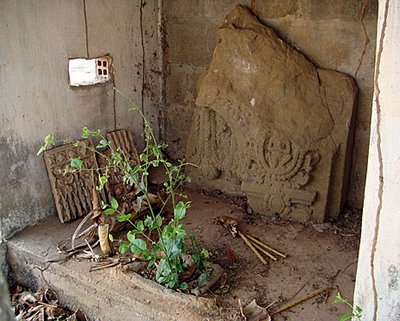 This fragment of lintel at Wat Chum is inside a small shrine next to the vihara
This fragment of lintel at Wat Chum is inside a small shrine next to the vihara It's Neak Ta time
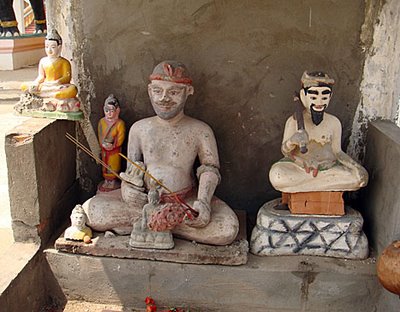 These Neak Ta images at Wat Toek Thla in Pochentong overlook a garment factory
These Neak Ta images at Wat Toek Thla in Pochentong overlook a garment factory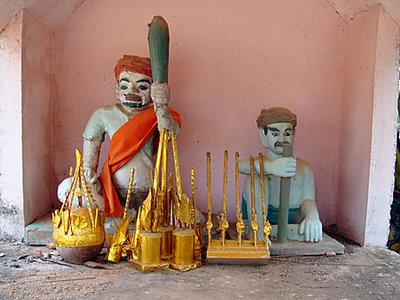 Two club wielding Neak Ta at Wat Tang Krasang Cheung
Two club wielding Neak Ta at Wat Tang Krasang Cheung Monday, March 3, 2008
Inside the ECCC
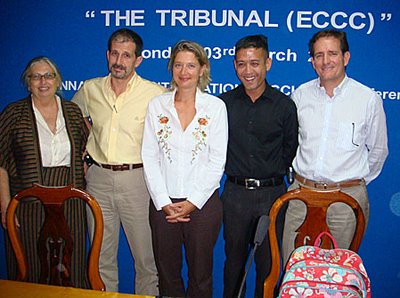 The Panel. LtoR: Helen Jarvis, Robert Petit, Caroline Schmidt-Gross, Hisham Mousar, David Boyle
The Panel. LtoR: Helen Jarvis, Robert Petit, Caroline Schmidt-Gross, Hisham Mousar, David Boyle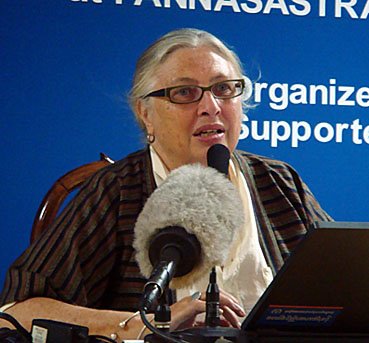 Helen Jarvis - Chief of Public Affairs, ECCC
Helen Jarvis - Chief of Public Affairs, ECCC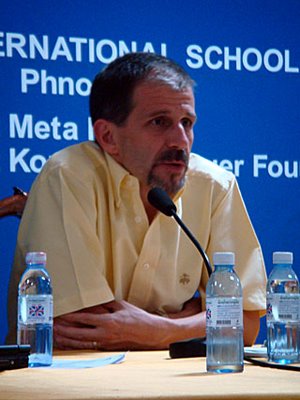
Robert Petit - Co-Prosecutor, ECCC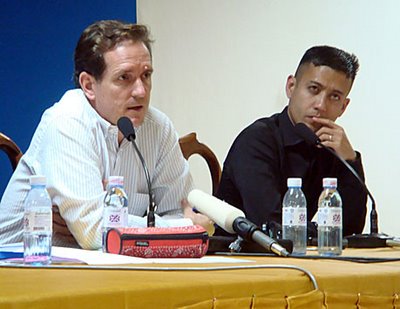 David Boyle - Investigator, Office of the Co-Investigating Judges, ECCC and Hisham Moussa, ADHOC
David Boyle - Investigator, Office of the Co-Investigating Judges, ECCC and Hisham Moussa, ADHOC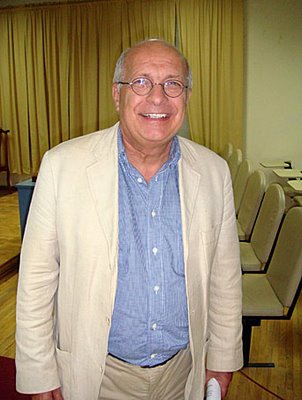 Raoul Jennar - veteran Cambodian analyst
Raoul Jennar - veteran Cambodian analyst
Everyday stuff
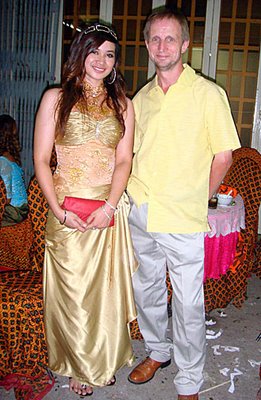 The author and Pisey, one of the staff from Cafe Fresco on Street 51 & 306
The author and Pisey, one of the staff from Cafe Fresco on Street 51 & 306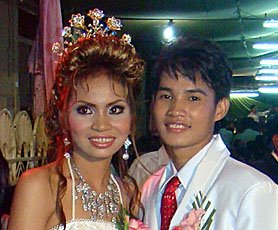 The happy couple - Chenda & Seyhar
The happy couple - Chenda & SeyharI'm interviewing most days this week at work as we try and get some good quality staff into our ever-expanding tour company. I'm also assisting a documentary film-shoot this week, which I'll tell you more about as it happens. Tonight, don't forget it's the fifth of the public forums on the Legacy of the Khmer Rouge, beginning at 7pm at Pannasastra University on Street 370 in BKK1. Oh, and last Friday I spent all day at an eco-tourism workshop, under the CCBEN umbrella, which I'll also tell you more about in a post this week. It's a hectic schedule, but fun.
News-wise, for the view of the well-respected researcher Sara Colm, on the current Khmer Rouge Tribunal, click here. Colm is from the United States and currently works in Cambodia for Human Rights Watch. She graduated in psychology from the University of California, Santa Cruz, in 1979. Her post-graduate work at Cornell University included Southeast Asian studies and the Khmer language. She also speaks Mandarin and French. In 1992, she moved to Cambodia and helped launch The Phnom Penh Post, the first English-language newspaper published in Cambodia in 20 years. She served as managing editor, wrote stories and oversaw all aspects of newspaper production. Subsequently she worked for the United Nations peacekeeping mission in Cambodia as an information officer and human rights monitor during the 1993 electoral campaign.
Sunday, March 2, 2008
Wats west of Phnom Penh
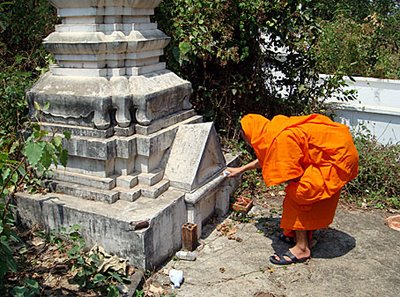 Kumtoung, the head monk of Wat Tang Krasang Cheung inspects a chedi inscription
Kumtoung, the head monk of Wat Tang Krasang Cheung inspects a chedi inscriptionThe pedestal that I expected to find was too well hidden for my beady eyes, so I moved onto Wat Chum, which was much more generous in its offerings. Sat under one of the pagoda's old trees was half of a lintel, most likely carved in the Sambor Prei Kuk era, that had been white-washed. Inside a Neak Ta spirit house, most of the other half of the lintel resided. Nearby were two sandstone pedestals but nothing else, despite an exhaustive search of the grounds of the pagoda. In the next village, Wat Chhouk Va hosted a light picnic after I stopped to buy some cooked-on-the-spot sausage, beef and vegetables, as well as a pedestal inside a stupa and some old-looking chedis. Passing the Royal Phnom Penh golf course, Wat Tekkhabanhor beckoned, but apart from some seima stones from the year of the pagoda's construction, 1953, and a very friendly head monk, Ham Sovann, there was nothing else of note. At Wat Arun Vatei I found a small fragment from a lintel lying in the grass near the vihara and at Wat Kok Banhchan, some laterite blocks looked promising but aside from watching some monks putting their backs into some manual labour, my search for further treasures proved fruitless and I headed for home. I was never further than about 25 kms from the city and whilst i didn't unearth any major discoveries, its was a pleasant Sunday afternoon diversion along rural roads that see virtually no foreigners whatsoever.
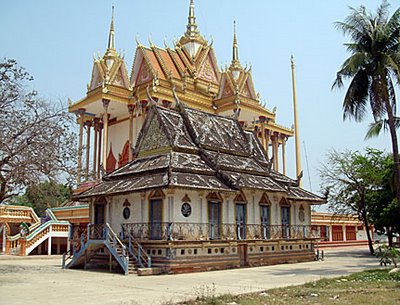
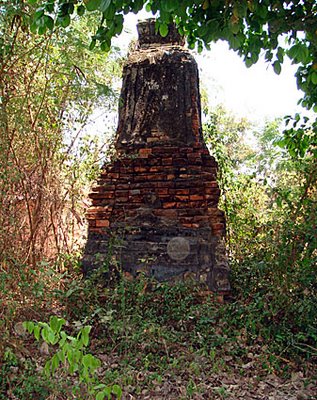
One of the brick-built stupas at Wat Tang Krasang Cheung, dating from 1280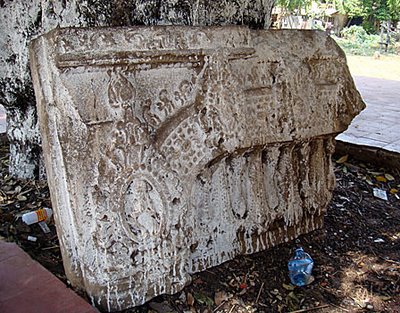
The white-washed Sambor Prei Kuk era lintel at Wat Chum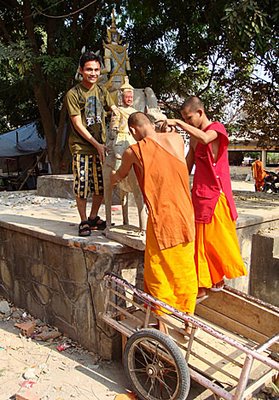
Two young monks putting their backs into moving a statue at Wat Kok Banhchan
Saturday, March 1, 2008
More old and more new at Nokor
On the bookshelves
Three books I missed at the back-end of last year include Where the Stone Flowers - The People of Angkor by Thanakvaro De Lopez. A Khmer scholar studies the social, economic and environmental aspects of present-day Angkorians. 218 pages, by Blue Reamker Productions and published last September. Tim Winter's Post Conflict Heritage, Post Colonial Tourism: Tourism, Politics and Development at Angkor is from the Routledge stable and has been around since December. The award for the book with the longest title, ever, goes to the Story of a Khmer Rouge Holocaust Survivor & the Creation of the Kosol Ouch/David Lowrance Rain Maker Device. I kid you not! 204 pages from e-booktime publishers, in paperback and in e-book form, its the survival story of Rattana Keo Phuong, co-authored with Kosol Ouch, David Lowrance and David Dawson.
Old and new at Wat Nokor
 The colourful modern wat is built around the sandstone porch facing east of the prasat's vihara
The colourful modern wat is built around the sandstone porch facing east of the prasat's vihara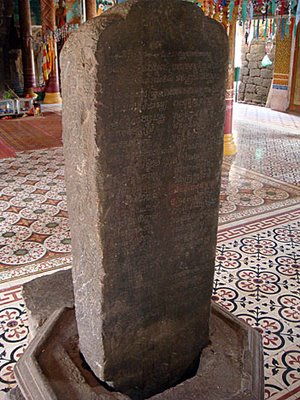 An inscription stone inside the pagoda providing important details about its construction
An inscription stone inside the pagoda providing important details about its constructionSouth coast developments
Forced evictions are the regular headlines in the local media here almost every day and Sihanoukville is having its fair share with evictions at Ochheuteal, Independence and Otres beaches in recent months. Mysterious fires have destroyed some of the property and by coincidence of course, remains an effective way of getting people out of their homes or businesses.
I don't have the full facts about the re-opening of the road to the top of Bokor Mountain yet but my spies tell me that the National Park rangers have been co-opted into the scheme and will take passengers up the new road to the summit about three times each day, for a price in excess of $70 per car. The road is still some way from being finished so visitors are being limited and no private car or motorbike is being allowed on the road. Businesses in Kampot have already experienced a decline in their through the door traffic with the closure of Bokor and just as the town was becoming a regular on the itinerary of many travellers, it could find itself amongst the 'also-rans' again. I hope not, as I have a soft spot for the town. Find out more about Kampot here.
